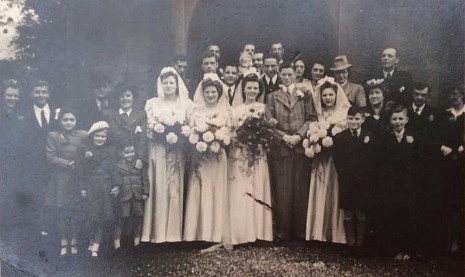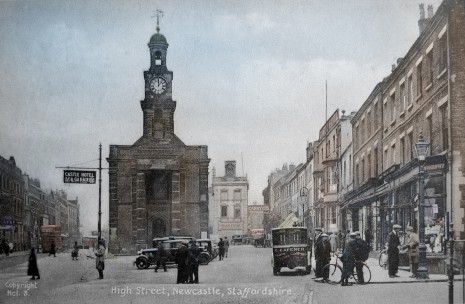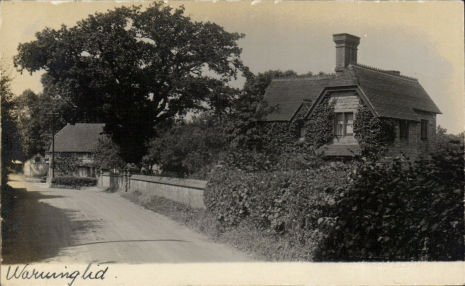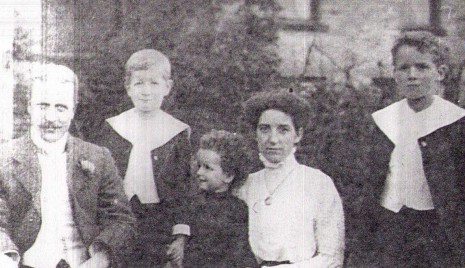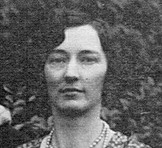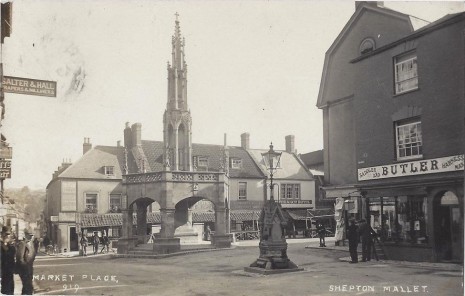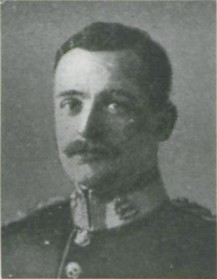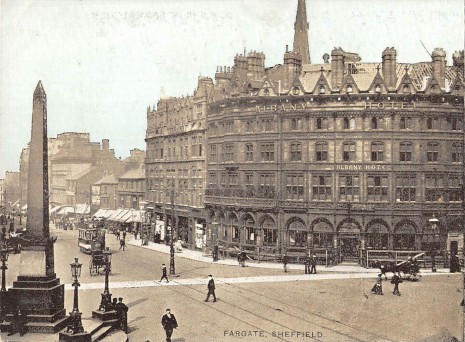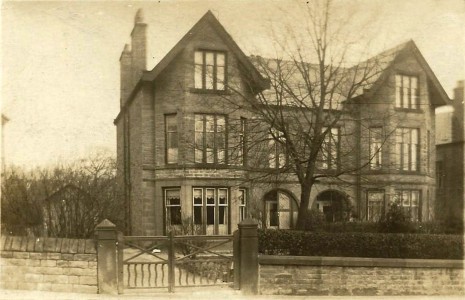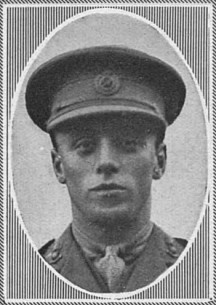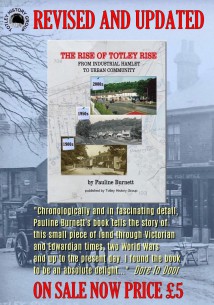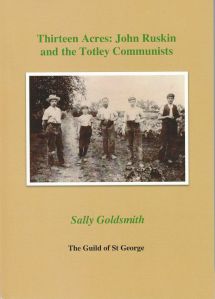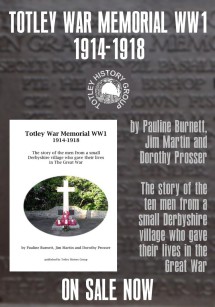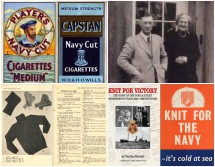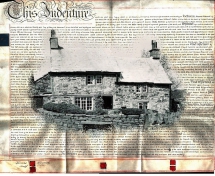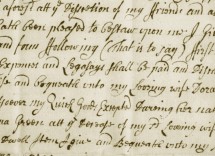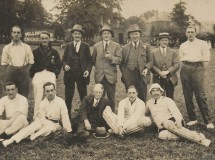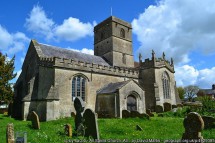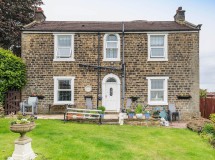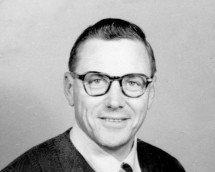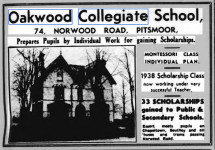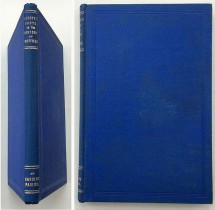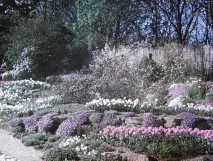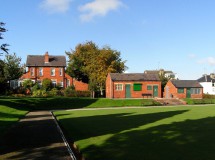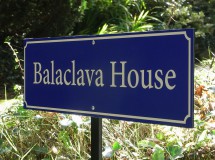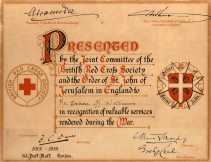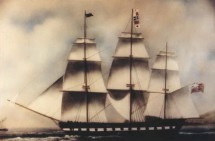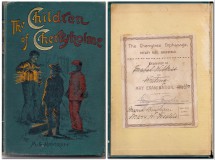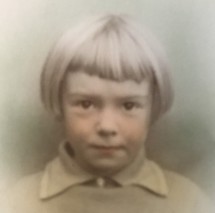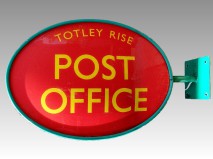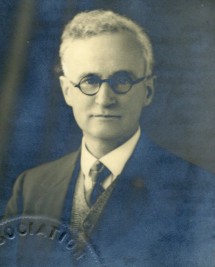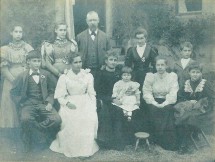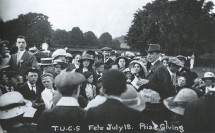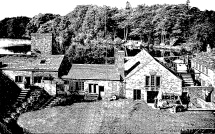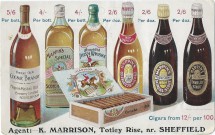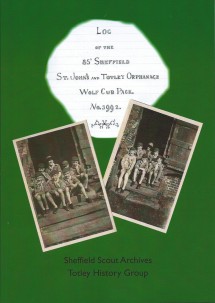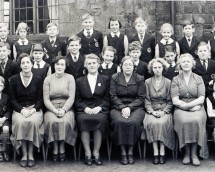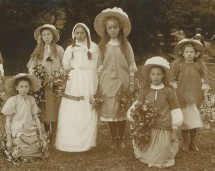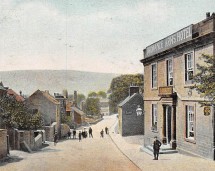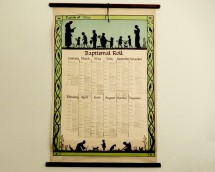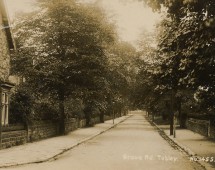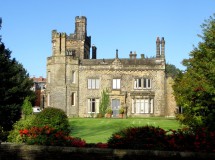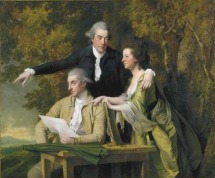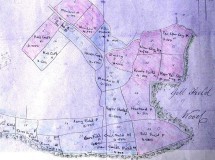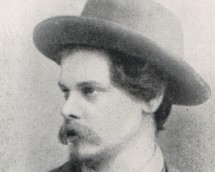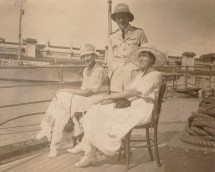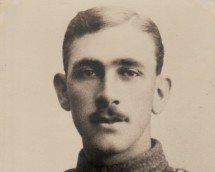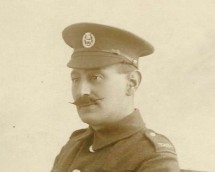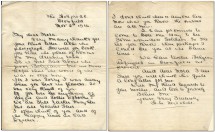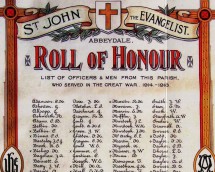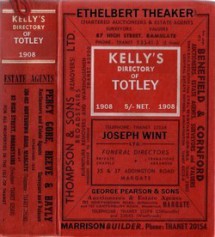WW1 Roll of Honour - The Survivors L-R
Please see War Memorials and Rolls of Honour for the names of local WW1 soldiers and links to other soldier's stories.
William Thomas Lees
William Lees was born in Brightside, Sheffield in 1881. His father was Charles Lees who was born in 1856 in Knightley, Staffordshire the fourth of five children of John Lees, a farmer, and his wife Mary Tildesley who married on 8 January 1845 at St. Michael, Stone, Staffordshire. William's mother was Martha Ann Caley who was born in 1854 in Stafford, the youngest of three children of William Caley, a joiner, and his wife Martha Forrester who had married on 11 August 1847 at Braddan in the Isle of Man.
Charles and Martha Ann married on 20 June 1877 at Holy Trinity, Bordersley in Warwickshire. Charles was a joiner and carpenter. They had moved to Sheffield by the time of the Census on 3 April 1881 and were living at 33 Normanton Street, Brightside. With them was Martha Ann's widowed mother, her father having died the year after she was born. William was born soon after on 18 April and baptised on 18 May at All Saints, Brightside. A second son Alfred was born in 1883 when the family were living at 111 Charlotte Road, Highfield and they were still living there in the 1891 Census, daughter Anne having been born in 1887 and son John James in 1889. Finally Ellen Kathleen was born in 1894 in Sheffield but baptised in Gnosall, Staffordshire the following year, when the family had presumably returned to the Lees family farm at Knightley, following the death of William's grandfather John Lees.
It then appears that Charles and Martha Ann's marriage broke down and the family fragmented. In the 1901 Census Martha was living at Cowley Bar, Holmesfield with the two youngest children, John and Ellen. Anne was working as a domestic servant in Sheffield. William and Alfred were both living at Totley Rise. William had married Ann Elizabeth Taylor in 1900. Ann was born in Sheffield on 3 October 1882, the eldest of six children of George Taylor, a gas works labourer, and his wife Mary Ann Price who had married at St. Philips, Shalesmoor on 1 January 1882. In 1901 William and Ann were living at 12 Totley Rise (37 Baslow Road) with their first child Edith Mary aged 11 months. Alfred was working as a joiner's apprentice, presumably to his brother, and living nearby with Ann's widowed father and his other surviving children.
We have not be able to find Charles Lees in the 1901 Census but ten years later he was working for a brewery in Mansfield and living at 27 Cemetery Road with a much younger housekeeper, Rose Hope, to whom probate was granted after his death on 16 October 1914. Ellen was also in Worksop in 1911, working as a kitchen maid. Alfred was a boarder in Carver Street, Sheffield, still a joiner and single. John was a joiner's machinist, boarding in High Fishergate, Doncaster. Anne had married Joseph Bates on 26 December 1906 at St Paul, Norton Lees and was living at Bolehill, Norton Woodseats with their two children, Elsie and Arthur.
By 1911 William and Ann had produced six more children, all born at Totley Rise: Elsie (1901), Dora (1903), William Leslie (1905), John Joseph (1906), Nellie (1908) and Gladys Annie (1910). Another daughter Rosalind Maria was born in 1912. The children were all baptised at St John the Baptist, Abbeydale.
William's war service record has not survived and his service medal card cannot be positively identified from the brief information they contain. There is a William Thomas Lees, a driver with the Royal Field Artillery and later the Royal Horse Artillery who was sent to France on 6 September 1915, but no address or next of kin is recorded. What we do know is that in September 1916 William was fined for failing to screen household lights and that in 1917 another daughter, Elizabeth, was born so perhaps his war ended early. A tenth child, Minnie, was born on 15 July 1919. The children were sent to Totley Church School and all survived until adulthood.
At the time of the 1939 National Register William and Ann were still living at 37 Baslow Road with their daughters Gladys and Minnie. Whilst both girls married and moved away, William and Ann stayed at the same house for the rest of their lives. They both died in 1966 and were buried at Dore Christ Church, William on 29 March aged 84 and Ann on 27 May aged 83. The following year John and Iris Scriven opened their shop called Fruiterama at number 37 and were later joined by their son Martin who still runs the business.
Douglas Henry Loukes
Douglas Loukes was born in 1880 in Brightside, Sheffield. His father was Charles Rippon Loukes who was born on 4 December 1849 in Sheffield, the fourth of eleven children of Henry Loukes, a saw handle maker, and his wife Selina Rippon who had married in Sheffield in 1844. Douglas's mother was Rebecca Wilkinson who was born in Selby in 1852, the third of four children of William Wilkinson, a rope maker, and his wife Ann Robinson who married on 7 May 1848 at Selby Abbey Church.
Douglas's parents married at the Selby Abbey Church on 3 September 1876. Charles was a pearl and ivory carver and fluter working in the cutlery trade in Sheffield. In the census on 3 April 1881, Charles and Rebecca were living at 78 Petre Street, Brightside with the first three of their children: Charles William Rippon (born 10 September 1877), Rebecca Wilkinson (born 6 October 1878) and Douglas Henry (born 10 February 1880). Five more children were born before the next census: Frederick Percival on 3 October 1881, Bernard Robinson on 6 July 1883, Laurence Ewart on 13 July 1885, Sidney Harold on 16 April 1887 and Lilian Irene on 3 June 1889. In the next census on 5 April 1891 the Loukes family were living at 12 Burngreave Bank.
The Loukes were at the same address in the 1901 Census which shows that three of the sons, Charles, Frederick and Laurence had followed their father's occupation. Bernard had become an accountant's clerk whilst Douglas had become an architect's clerk. He had passed national examinations at Sheffield School of Art in Architecture and Technological Drawing in 1899. In 1905 Douglas was a prizewinner at the Sheffield Society of Architects and Surveyors annual awards. The following year he married Alice Maud Trower who was born in Sheffield on 19 March 1881, the fifth of seven children of William Trower, a fitter and turner, and his wife Sarah Ann Lighton who had married in Norwich, Norfolk in 1869.
Douglas and Alice had two children born in Sheffield, Dorothy on 7 April 1908 and Donald on 18 February 1911, shortly before the census was taken which showed them living at 364 Pitsmoor Road. Soon after they must have moved to Totley because both Kelly's and White's trade directories for 1912 show them living at Inglewood, 40 Main Avenue. A third child, Nora, was born on 10 June 1916. Kelly's Directory for that year shows Douglas at the same address.
Presumably after 1916, he must have enlisted in the Notts and Derby Regiment (the Sherwood Foresters). All we have seen is his war pension record that shows that when he was discharged on 29 November 1919 he was Acting Corporal D. H. Loukes, number 204766. Douglas received a disability pension as a result of varicose veins (aggravated by military service) and "DAH", disorderly action of the heart, (attributable to military service). Three of Douglas's brothers also served in the army during the war and survived. Bernard, Lawrence and George all served with both the Lincolnshire Regiment and the Labour Corps and were each awarded the British War Medal and Victory Medal.
Douglas's older brother Charles had married Sybil Blythe Watson in 1904. Three daughters were born in Sheffield before the family moved to Totley at much the same time as Douglas and his family. Their eldest daughter, Gladys, was admitted to Totley Church School in April 1913, the same month as Dorothy but being a year older she had been previously schooled at Firshill. Charles and his family also lived at Main Avenue. He was now managing the family pearl and ivory fluting business at 8 Holtwood Road, Pitsmoor following the death of his father. Charles and wife Sybil were still in Totley in 1939 having moved to 11 Green Oak Road.
Douglas and his family, however, left our area in the early 1920s to go to Cambridge. They lived at 55 Victoria Park in 1925 and were still there ten years later. By 1939 they had moved to nearby 6 Gilbert Road, both addresses being in the Chesterton district of the city. In the same year Douglas designed a new drill hall for the Territorial Army in Ely and in 1940 he was elected as a Fellow of the Royal Institute of British Architects. Alice Loukes died on 14 April 1957 at Hope Nursing Home, Cambridge. She was aged 76. After her death Douglas moved to 68 Green End Road, Cambridge. He also died at Hope Nursing Home on on 12 February 1960, two days after his 80th birthday.
Edward Montague Marvin
Montague Marvin was born in Bath, Somerset in 1887. His father was Edward James Marvin who was born in Devizes, Wiltshire in 1860, the third of five children of William Marvin, an innkeeper, and his wife Sarah Ann Browne who had married on 9 July 1855 at St. Mary, Redcliffe, Bristol. Montague's mother was Sarah Ann Edwards, known as Hetty, who was born in Urchfont, Wiltshire in 1863, the seventh of eight children of William Edwards, a blacksmith, and his wife Sarah Ann Mathews, who had married at St. Michael and All Angels Parish Church, Urchfont on 11 November 1847.
Montague's parents married at St Michael and All Angels on 29 April 1884. Edward Marvin was a laywer's clerk living in Southam, Warwickshire and it was there that their first child, Elsie Millicent, was born on 17 January the following year. Montague was their next child born in Bath, Somerset on 4 February 1887 when Edward was working as the Deputy District Auditor of the Somersetshire and Dorsetshire Audit District.
By the time of the census on 5 April 1891, the Marvin family were living at Avenue Terrace, Ingatestone, near Chelmsford where Edward was working as an accountant. A second daughter, Kathleen Winifred, was born at Ingatestone in 1893 but she died aged 9 months and was buried on 14 June 1894. In 1899 Edward received an inheritance from the estate of his late sister, Elizabeth, who lived in Hammersmith, London and in the 1901 Census the Marvin family were living at 93 Addison Gardens, Hammersmith. In 1907 Edward was appointed to the position of County Accountant with Kent County Council and the family moved to Maidstone where they lived at 7 Summerfield Terrace. Edward stayed in the same post until his retirement on 30 September 1929.
Montagu Marvin became a student member of the Institution of Electrical Engineers in 1907 and in 1911 he was a special pupil at the Institution's Newcastle Upon Tyne section living at 9 Noble Terrace, Gateshead. By 1914 he had progressed to an Associate Member and was living in Maida Vale, London. With the outbreak of war, Montague received a commission as a Temporary Second Lieutenant in the Royal Engineers on 9 January 1915.
On 1 July that year he married Lily Brocklehurst at St. John the Baptist, Abbeydale. Lily was born in Sheffield on 23 June 1893, the second of three children of Arthur Brockleburst, a yeast merchant, and his wife Elizabeth Barlow who had married in Sheffield in 1889. By the time Lily was four her parents and her two brothers were all dead and she was brought up by her mother's sister Annie and her husband, Herbert Methley, a yeast agent who lived at The Laurels, Dore Road. Their son Arnold Methley is another soldier whose name appears on the Roll of Honour at St. John's.
On 26 August 1915 Montague was promoted to Temporary Lieutenant. He was sent to France with the 129th Field Company disembarking on 28 November 1915. On 31 May 1916 the London Gazette reported that he had been awarded the Military Cross "for conspicuous gallantry. He went out and rescued a severely wounded man of a working party, carrying him on his back some hundred yards in bright moonlight under heady machine gun and rifle fire." By the end of the war, Montague had been promoted to Major.
Lily and Montague's first child, Edward, was born at The Laurels on 1 January 1919. They went to live at South View, Daws Lane, Hendon where a second son, John Montague was born in 1921. By 1928 the family were living in Wembley at Newhaven, Harrow Road, Sudbury. Montague had become an acoustical engineer. He worked for the Merchant Trading Company of Bishopsgate, London on contracts for adapting theatres and designing cinemas suitable for "talkies". The Regal in Rugby (1931) and Rex in Coventry (1936) were highly praised examples of his work.
However, by the time of the 1939 National Register, the Marvin family were back in Sheffield, living at 53 Whirlow Court Road, and Montague's occupation is shown as automobile engineer. After Montague retired, he and Lily went to live at Somercot Cottage, Main Street, Caldecott, Rutland. Lily died on 9 March 1960, aged 66 and Montague on 12 February 1968 aged 81.
Samuel Mather
Sam Mather was born in Holmesfield, Derbyshire in 1895. His father was William Aaron Mather who was born in Edensor, Derbyshire in 1850 the eighth of nine children of Joseph Mather, a farmer, and his wife Martha Taylor who had married on 14 November 1830 at St. Peter, Edensor. Sam's mother was Mary Billam Frith who was born in Eckington, Derbyshire in 1864, the younger child of James Frith, a scythe grinder, and his second wife Sarah Ann Billam who married on 19 October 1862 in Sheffield Parish Church. Mary was just 12 days old when her father, who worked in Sheffield for Messrs Sorby, lost his life in the Great Sheffield Flood which destroyed his lodgings at the Stag Inn, Malin Bridge.
William and Mary married 27 June 1887 St. Giles, Matlock. William had been a draper but like his father, he later became a farmer. Their first child, Hannah, was born at Eckington later in the year and soon afterwards the family moved to Cartledge Grange Farm, near Holmesfield where seven more children were born: William (1889-89), Sarah (1890), Joseph (1893), Sam (1895), Evelyn (1898), Billy (1902) and finally an unnamed boy (1904) who died soon after birth. In 1905, after 17 years as a farmer, William was forced into bankruptcy which he attributed to a loss of livestock, illness and heavy interest on borrowed money. A first and final dividend was paid to creditors of just 1s. 3 3/8d. in the pound. He continued to farm at Cartledge, helped by Mary and all the surviving children until around 1913.
Sam Mather's war service record was destroyed but his medical record survived. It tell us that he enlisted in the Derbyshire Yeomanry at Holmesfield on 15 October 1914 and was promoted to Lance Corporal on 27 August 1915. It also says that he served 4 years 176 days entirely on the Home Front. However, Archie Thomas wrote that Sam served in France with the Yeomanry which is entirely possible as 165 men and four officers were drafted to France in October 1916 to support the 14th Battalion of the Durham Light Infantry.
The Regiment was converted to the Derbyshire Cycling Regiment and was stationed in Kent near Canterbury in 1917 and 1918. This must have been how Sam met his future wife, Elsie Winifred Hall, who had been born on 20 January 1890 in Folkestone. Elsie was the youngest of nine daughters of Thomas Hall, a mariner, and his wife Fanny Elizabeth Fittall who had married at the Church of St. Peter and St. Paul, River near Dover on 25 December 1867. Sam and Elsie were married at Eastry, Kent on 18 April 1917.
By the time Sam was discharged on 8 April 1919 his parents and several siblings had moved to Lemont Road, Totley. Mary Mather had been a valuable member of the the VAD staff at St. John's Church Rooms during the war. Hannah, Sarah and Billy were living with their parents and number 5. Joseph had married Jessie, the daughter of Alfred and Lydia Stevenson of Moorwood Farm at St. Swithin's, Holmesfield on 28 January 1917. He became a dairyman and lived at number 34, Lemont House.
Sam and Elsie had five children: William (1921), Reginald Thomas (1924), Dorothy Winifred (1929), Samuel Vernon (1931) and June Mary (1933). In 1939 the family were living at 2 Milldale Road, Totley Rise. Billy married Amy Heath at Christ Church Heeley on 29 August 1926. Amy was born in Heeley, the fifth of eight children of John Heath, a pork butcher, and his wife Emma Yeomans who married on 25 January 1891 at St. Paul, Pinstone Street. Sheffield. Billy and Amy lived at Rolling Mill Cottages, Mill Lane.
For many years, Sam and Billy worked for Colin Thompson, a farmer and butcher whose shop was at 69 Baslow Road. They were engaged mainly on Colin's farm which occupied many acres of Heatherfield and Totley Rise, and was used both for grazing cattle and for growing fodder. Sam's son Vernon later managed Colin's second shop in Dore.
Elsie died in 1944 aged 64. Sam remarried in 1948 to Eileen Elizabeth Charles who was born on 24 November 1902 in Bradwell, Derbyshire the third of four children of Thomas Pickford Charles, a
gardener, and his wife Martha Ann Marshall who married in 1900 at the Wesleyan Methodist Chapel, Bradwell. Eileen was the widow of Richard Spencer, a motor engineer. Sam Mather died in 1953 aged 56.
Eileen died in 1988 aged 85.
Harold Hobson Mawson
Harold Hobson Mawson was born in Attercliffe, Sheffield on 14 April 1893. His father was John William Mawson who was born in Sheffield on 5 February 1869, the only son of William Mawson, a butcher, and his wife Catherine Hobson who married at Holy Trinity Church, The Wicker on 31 March 1868. Harold's mother was Mary Hannah Armitage, known as Polly, who was born on 18 July 1872 at Blacker Hill, near Worsbrough, the fourth of five children of John William Armitage, also a butcher, and his wife Jane Newboult who had married in Barnsley in 1862.
The Mawson family's connection with Totley dates from around 1880 when William Mawson, Harold's grandfather, moved his butchers business here from Addy Street, Upperthorpe. William was probably the first tenant at the newly built shops at the top of Bricky Row (69 Baslow Road). From newspaper advertisements we can see William was still there in 1889 but by 1891 he had moved to 11 Ellin Street, Moorfoot, Sheffield. John followed his father's trade and in the 1891 Census he was working as a butcher's journeyman on a farm in Worsbrough. John married Polly Armitage on 18 October 1892 at Worsbrough Parish Church. He may have been working for the Armitage family who had a butchers shop at Blacker Hill.
Harold was John and Polly's first child, born the following year, when they were living at 29 Attercliffe Road. They must have moved around a lot in the next few years judging from the baptisms of their children. Leonard was born on 1 December 1904 when they lived at at Woodbine Cottages, Tankersley; Reginald was born on 26 March 1897 when they lived at Prospect Place, Hoyland; John William junior was on 23 January 1900 when they lived at Queen Street, Hoyland Common. In the Census on 31 March 1901 the Mawson family were still living at Queen Street but John's occupation was no longer a butcher. He had become a labourer at a chemical works.
By 17 June 1901, however, the Mawson family had moved to Greenoak, Totley, the three eldest boys being admitted to Totley Church School on that day. In August 1902 Harold came second in a competition for boys aged 9-10 at the 18th Annual Dore, Totley and Holmesfield Agricultural and Horticultural Society's Exhibition. Hedley Bishop, one of the ten soldiers on Totley War Memorial came first. John and Polly's next child. Muriel, was born in Totley and baptised at Christ Church, Dore on 23 September 1903. Their stay in our area was a relatively short one, however, as their sixth child, Marjorie Sheila was born in Barnsley in 1910.
In the Census on 2 April 1911, Harold is recorded as being a draper's assistant but on 9 October that year, when aged 18, he enlisted as Private number 3224 in the 2nd Battalion of the Northumberland Fusiliers. He stayed with the army for more than seven years. Harold's WW1 service record has not survived but we know from later documents that he was sent to France with the British Expeditionary Force on 8 February 1915 and that he suffered a gunshot wound to the head. He was discharged on 22 January 1919 having been promoted to the rank of Colour Sergeant (Company Quartermaster Sergeant). The reason given for his discharge was that he was no longer fit for war service. Harold was later awarded the 1915 Star, British War Medal and Victory Medal.
Whilst he was in the army, Harold married Margaret McArdle in Barnsley on 20 November 1916. Margaret was born on 14 or 15 April 1895 (dates vary) in Sunderland, Durham, the seventh of ten children of John Patrick McArdle, a road labourer, and his wife Sarah Ann Alderson who married at St. Paul's, Hendon, Durham on 24 July 1877. During the war Margaret lived at 2 Grace Street, Sunderland. Her two younger brothers, Philip and Bernard, served with the Durham Light Infantry.
After leaving the Army, Harold enlisted in the RAF on 22 August 1919 and was promoted to sergeant eight days later. It appears that the gunshot wound from WW1 was no handicap to his employment as a payroll clerk but when it was found that he also had a heart condition he was once again discharged unfit for service having served only 140 days in the RAF. He became an accountant and on 4 December 1938 he again enlisted as an RAF reservist. He was recalled from reserve on 25 August 1939 but we have no further information about his service during WW2.
Harold and Margaret had four children: Sheila born in Barnsley in 1918, Doreen born in Sunderland in 1919, Harold junior also born in Sunderland in 1921 and finally Kenneth born in Barnsley in 1927. By 1939 Harold's family were living at 155 Doncaster Road, Barnsley, close to his parents who were at number 230. Harold and Margaret later moved to 163 Doncaster Road where Margaret died on 14 May 1972 aged 77. We have been unable so far to confirm the date of Harold's death.
Arnold Methley
Arnold Methley was the oldest child of Herbert Methley and his wife Annie, née Brocklehurst. Like his father Charles, a silversmith, Herbert had been born in Sheffield. In 1889, Herbert married Annie Brocklehurst, the daughter of William Brocklehurst, a yeast dealer who had been born in Calver, and his wife Mary Ann, née Bearder, who had been born in Sheffield.
In 1891, Herbert and Annie were living in Ecclesfield; Arnold, their first child, had been born there on 31 March 1890. Herbert, then aged 27, was a book keeper at a rolling mill. Herbert and Annie later had two daughters, both born in Sheffield: Laura (born in 1894) and Sybil Annie (born in 1897).
By 1901, Herbert was a yeast agent, and was living in Norton with his wife and their three children. The household also included his wife’s niece Lily Brocklehurst, aged 7, and her first cousin Clara Bearder, aged 21, who had also been born in Sheffield; though she has no specified occupation, Clara was listed after the general domestic servant, which suggests that she was perhaps not regarded simply as a member of the family.
Herbert seems to have flourished in his new occupation: in 1911, he described himself as the managing director of a yeast company. At that time, the Methley family, who had moved to Dore by 1907, were living at The Laurels, Dore Road. The household now comprised Herbert, Annie, Arnold and Sybil Annie, and Lily Brocklehurst (who would later marry Edward Montague Marvin); while Clara Bearder is still present, her relationship to Herbert was now described as that of a servant rather than a relative; she was one of the Methleys’ two resident housemaids. Laura had sadly died in 1908, aged 14, and is buried in Dore Churchyard.
In 1911, Arnold was described as a clerk in a yeast company – most likely the company in which his father worked. In 1914, he married Constance Edith Beardshaw, who had been born in Brussels. Constance was the daughter of steel merchant Charles James Beardshaw and his wife Constance, who had been born in Boulogne of British parents. In 1911, the Beardshaw family was living in Heeley. Arnold and Constance appear to have had four children, the eldest, Herbert Garrow, being born in Heeley on 22 March 1916.
Arnold served as a Lieutenant in the Territorial Force battalion of the Royal Field Artillery, suggesting that he was a member of the TF before the war. The Dore & Totley Parochial Magazine indicates that he had joined the army by March 1915. Given his occupation, he may be the A. Methley who is recorded on the Roll of Honour listing the employees of the United Yeast Co. Ltd, Manchester, who were serving with His Majesty’s Forces in 1914-1916. Whilst relatively little is known of his war service, he evidently served with distinction in the Balkans: the London Gazette Supplement of 3 June 1919 records that he was mentioned in despatches by the Commander in Chief of the British Salonika Force for distinguished and gallant services at some time between 1 October 1918 and 1 March 1919.
Arnold survived the war. A daughter, Constance Annie (known as Bubbles) was born on 14 August 1920. Two more children followed after the family moved to Sutton Coldfield, where Arnold was the resident director of the United Yeast Company. Lallie was born on 21 August 1923 and Arnold Eric in 1925.
Arnold had a love of sport, especially billiards and cricket. He gave a gold cup to the Midlands Billiards Association to be competed for annually and, through his close connections with Yorkshire County Cricket Club, raised funds for local charities by organising cricket matches between his employer's team and the Yorkshire 1st X1. When he moved to Grantham in December 1937 to run the Waggon and Horses Hotel on Manthorpe Road, part of his collection of autographed bats was displayed behind the bar. His most prized bat was given to him by Herbert Sutcliffe. It was the bat Sutcliffe used to score centuries in both innings against South Africa in The Oval Test of 1929.
Arnold and Constance were living at 2 Watergate, Grantham when Bubbles married Lieut. Geoffrey Neville Zeylmans in 1945 but so far we have been unable to find out what happened to them afterwards.
John Mifflin
John Mifflin was born in Newcastle under Lyme, Staffordshire on 5 September 1891. His father was Sampson Mifflin who was born in Newcastle in 1868, the second of six children of Sampson Mifflin Senior, a joiner, and his wife Mary Jane Pye who had married at St. Nicholas, Liverpool on 28 August 1865. John's mother was Jennie Lovatt who was born in Wolstanton, Staffordshire on 28 November 1866, the seventh of eleven children of James Lovatt, a farmer, and Emma Riley who married at Wolstanton Parish Church on 18 July 1853. Emma was the widow of George Cartwright, a collier, whom she married in Audley, Staffordshire on 11 February 1850.
John's parents married on 2 May 1889 at St. George, Newcastle under Lyme. Their first child, Harold, was baptised at St. George on 27 August 1889 when they were living with Sampson's parents at 9 North Street. By the time their second child Lilian was baptised on 10 September the following year, they were living at the Lamb Inn, 29 High Street, Newcastle where Sampson was the manager of the pub. Lilian died the later the same year. Two more children were born whilst Sampson and Jennie were at the Lamb Inn: John, baptised on 25 October 1891 and Archibald on 19 February 1893.
In January 1894 Sampson found himself unemployed and advertised for work as an experience barman, used to quick counter trade, and with good references. He gave an address of 9 Newcastle Street, Penkhull, Stoke on Trent. However, when the next child, Hilda, was baptised on 27 November 1894, the Mifflins were living at 31 Croft Street, Newcastle. Their sixth child, Mary Adelaide, was baptised at St. George on 27 October 1897 when they had moved again to 5 Bow Street. She died at the age of two.
In the census of 1901 Sampson was at 9 North Street with his parents and son Harold. Jennie and the three youngest children were at 46 West Street. Jennie was working as a seamstress making shirts. We believed that there must have been some sort of family rift as we have been unable to find Sampson again until his death in Essex in 1942. Perhaps he was out of the country or using a false name to avoid his family obligations.
Harold joined the army attesting at Newcastle on 9 November 1903 when just 14 years of age. He named his mother and three siblings but made no mention of his father. Harold went absent without leave on 4 April the next year and it was found that he had irregularly enlisted in the 2nd Battalion of the King's Own Royal Liverpool Regiment. He was tried and sentenced to 56 days hard labour on 15 April. From there his life went from bad to worse. He used many aliases, enlisted at least twice more, married under a false name and deserted his wife after six months, and was in and out of prison mainly for theft, fraud and forgery. With the police from cities all around the country after him and short of money, he finally posed as an M.D. to obtain barbitone and took his own life in Birmingham's Grand Hotel on 16 September 1927.
Archie had been a potter's boy before he joined the Royal Navy at Portsmouth on 7 October 1908. He was initially at the base training ship HMS Ganges before serving short periods aboard the Impregnanble, Leviathan and Illustrious. On 27 December 1910 whilst on the King Edward VII he was elevated to Ordinary Seaman. Further short assignments on the New Zealand, Zealandia and Waterworth were followed by a further promotion on 19 April 1912 to Able Seaman. Two more short periods aboard the Pegasus and Victory were followed by four months on the Bulwark and five months on the Vernon during 1912-13. His service with the Royal Navy ended on 15 September 1913 following a 12 day assignment on the Queen Mary.
While Archie was at sea and Harold in India with the army, the Census was taken on 4 April 1911. Jennie, John and Hilda were living at 114 Hassall Street, Newcastle. John, aged 19, was a draughtsman in a tile works. Both Archie and John joined the army but only the most basic information has survived. Archie was a sergeant with the West Yorkshire Regiment and later the Labour Corps. There is no information on when or where he served overseas but he received a small allowance after the war for having contracted malaria during his time with the army. He was discharged on 4 May 1918 to an address in Staffordshire where his mother was living: 212 Oldbury Road, Smethwick. There is even less information about John's war service. All we know is that he became Sapper number 490218 in the Royal Engineers. Both men received the British War Medal and Victory Medal only, so did not see action abroad before 1916.
It was in early 1917 that John Mifflin married Edith Jane Bishop in Ecclesall Bierlow district. Edith was born in Dore, on 12 May 1899 the third of ten children of Colin Bishop, a gardener, and his wife Mary Ellen Kirk, who had married on 4 June 1884 at Christ Church, Dore. Colin and his family moved to Totley around 1898. In 1911 the Bishop family were living at Ivy Cottage, Mill Lane. However, Edith was a domestic servant in the household of Edwin James Roberts, a silversmith's cashier, at 29 Cliffefield Road, Meersbrook. Their son born in 1918 was named Eric Hedley Mifflin probably in memory of Edith's younger brother, Hedley Bishop, who died on the Somme on 21 October 1916 and is one of the ten WW1 soldiers named on Totley War Memorial.
The family were in London when their second child, Joan, was born on 21 January 1920. She was a typist for the heath service and still with her parents when the National Register was compiled on
19 September 1939. John was a buyer for a firm of sanitary engineers and the family were living at 19 Warwick Road, Southampton. Hilda had married Charles Allen, a clerk, in 1921 and had four
children. They were living with Jennie Mifflin at 212 Oldbury Road. Archie had married Jeanne Marguerite Julie Guillot, from Avrnches, France. They were living in the Channel Islands with their
Guernsey-born son Paul Frederick. Edith Mifflin died at the General Hospital, Birmingham, aged 55. John Mifflin died in Eastbourne, Sussex in 1978, aged 86.
William Ongley Miller
William Ongley Miller was born in Haywards Heath, Sussex in 1883. His father was Frederick Miller, who was born in 1850 in Hailsham, Sussex, the fifth of eight children of Edward Miller, a chemist and later photographer, and his wife Susannah Doubell who had married at Trinity Church, Maidstone, Kent on 23 August 1843. William's mother was Matilda Goldsmith who was born in Newenden, Kent in 1848, the fifth of seven children of William Goldsmith, an agricultural labourer, and his wife Sarah Manser who had married in Rye, Sussex in 1838.
In the 1871 Census, Fred Miller was in service as a footman in the household of William Brodie in Devonshire Place, Eastbourne, Sussex. Matilda Goldsmith was working as a parlourmaid for James Van Sommer in nearby Burlington Place. It would seem that they met through Esther Goldsmith, possibly Matlida's aunt, who was the Brodie's cook. After their marriage in Eastbourne on 4 March 1874 Fred and Matilda went to live in Brede, near Rye, Sussex where their first child Frederick Douglas was born on 6 December 1874. Their next child, Florence Matilda, was born in Brighton in 1879 but when the next census was taken, on 3 April 1881, the Millers had moved to 2 Vaudois, South Road, Haywards Heath and Fred had become an artist in watercolours.
Daughter Elsie Louisa was born on 2 June 1881 and William Ongley on 21 October 1883. William's unusual middle name had been passed down from Fanny Ongley who married his great grandfather Thomas Miller at St. George, Hanover Square, Westminster on 18 October 1814. Another son, Malcolm Doubell, was seven weeks old when the 1891 census was taken. The Miller family was recorded living at Gordon Villa, South Road, Haywards Heath. Fred was working as a school drawing master and eldest son Douglas had become an apprentice photographer, following his grandfather's trade.
In 1896 Douglas opened the Mid-Sussex Photographic Studio at 16 Boltro Road, Haywards Heath. The studio was spacious with reception rooms and Douglas was able to defray his costs by renting out part of his premises to an ophthalmic optician. He still lived with his parents, however, who by 1901 were at Laurel Villa, Sydney Road, Haywards Heath. On 18 February 1905, Douglas married Kate Elizabeth, the elder daughter of David Peerless, a timber merchant, at the Countess of Huntingdon's Church, North Street, Brighton.
By 1911 only daughter Elsie was left at home with Fred and Matilda at Laurel Villa. Douglas and his family were living at 9 Boltro Road, across the road from his original studio. Malcolm was at 12 Prince Albert Street, Brighton where he worked for and lodged with Stewart Acton who dealt in and restored antique pottery and porcelain. William who had earlier studied at the Brighton School of Art was now lodging at 36 Danvers Street, Chelsea and studying at the Royal College of Art. He was awarded their diploma later that year.
On 31 December 1912 William married Eva Worsley, a school teacher, at Tilston, near Malpas, Cheshire. Eva was born in Cheadle, Cheshire on 30 May 1888, the second of five children of Samuel Worsley, a joiner, and his wife Martha Ann Catterall who were married at St. Chad's, Prees, Shropshire on 9 March 1886. After their marriage they moved to our area where William took up a teaching role at Sheffield School of Art. They lived at Mooredge, (6) Leyfield Road, Dore. A daughter Winifred Elsie was born on 11 October 1913.
William was aged 31 when war broke out. He attested on 9 December 1915 in Sheffield and was mobilised on 24 June 1916. Two days later he was posted to the 3rd Battalion Notts and Derby Regiment (the Sherwood Foresters) as Private number 49226. William qualified on a rifle training course on 22 September 1916 at Tyne Garrison, East Boldon, near Sunderland but on 21 October he suffered an injury to his knee whilst on ordinary military duties at nearby Cleaden Hutments. It was thought to be a temporary injury and he was promoted to acting corporal on 28 October. However, the injury proved to be more serious than at first thought and he was transferred to army reserve on 3 April 1917 and finally discharged on 25 October 1917 no longer fit for war service.
William's younger brother Malcolm also served in the war, attesting in Brighton on 4 September 1914. He was posted to the Royal Army Medical Corps as Private number 40841. Malcolm's war lasted only 175 days before he too was discharged no longer fit for war service on 25 February 1915. His medical condition is not stated on the surviving pages of his war service record.
William's older brother Douglas had become very well known in mid Sussex. As well as studio photographs he also published postcards of scenes around Sussex that he and perhaps others had photographed. He also encouraged his wife, a pianoforte teacher, in her many activities including musical concerts and support for the Women's Total Abstinence Union and women's suffrage. Douglas became the secretary of the Haywards Heath Liberal club but he gave that up in June 1915 when the club premises were occupied by the army. In February 1916 he sold his photographic studios in Boltro Road to a competitor, Ebenezer William Pannell (1886-1951), and moved to 4 Westbourne Terrace, Worthing.
Douglas Miller had been granted exemption from combatant services as a conscientious objector. When he subsequently ignored his calling-up papers he was arrested as an absentee under the Military Services Act. He was brought up before the Mayor at the police station on 13 September 1918 and fined £2 and told that he had forfeited the protection he had received from combatant service by failing to answer his call-up notice. So far as we know that was the end of the matter. Douglas continued to make a living from selling picture postcards. The excellent Sussex Postcards website says that he published well over 1,500 different cards and with minor variations possibly as many as 2,500. Kate Miller died in Hove on 19 March 1959, aged 83. Douglas died on 7 June 1961 at the Southlands Hospital, Shoreham-by-Sea, aged 96.
Fred Miller died on 26 June 1917 at the Royal Sussex County Hospital in Brighton following a bowel operation. He was buried at the Extra Mural Cemetery, Brighton three days later. Fred had specialised in marine painting, working in both oils and watercolours, but he also painted landscapes particularly of scenes in the Cuckfield and Haywards Heath area. His works were exhibited at the Royal Academy and Royal Society of British Artists. His widow Matilda continued to live at Laurel Villa until around 1930 but later moved to 124 Waldegrave Road, Brighton where in 1939 she was living with her daughter Elsie and sister-in-law Flora. She died in Brighton in 1947, aged 99. Elsie died in Brighton in 1973. She was aged 92 and unmarried.
After leaving the army William resumed his role at the Sheffield School of Art until around 1920 when he took a post at the Manchester School of Art for several years before moving back south to become the Headmaster of Gravesend School of Art, Kent. In September 1928 he was short-listed for the post of Principal of the Sheffield College of Arts and Crafts, as it had become known, but was ultimately unsuccessful. In the 1939 Register William was the Head of the renamed Gravesend School of Arts and Crafts and was living at The Heights, 44 Pine Avenue, Gravesend together with wife Eva and daughter Winifred who had become an assistant mistress at a secondary school. Winifred married Gerard Henry Tallack, a journalist with the Financial Times, in 1941.
After William retired, he and Eva continued to live at The Heights until her death on 11 February 1957, aged 68. William later lived with his daughter and son-in-law at 38 Canonbury Park South, Islington. Middlesex. He died on 10 May 1960 at St. Joseph's Hospice, Mare Street, South Hackney. He was aged 76. His works were exhibited at the Royal Academy, Walker Art Gallery, Liverpool and Manchester City Art Gallery which still holds a rather unflattering portrait of his daughter which he painted in 1929.
John Lamont Murdoch, William Kirkwood Murdoch, Harry Lamont Murdoch, Percy Lamont Murdoch and James Mackie Lamont Murdoch
The five Murdoch brothers were all born in Sheffield. Their father was John Murdoch who was born in 1855 in Lesmahagow, Lanarkshire, the first of eight children of John Murdoch senior, a farmer, and his first wife Mary. Their mother was Jessie Armour Lamont who was born in Birkenhead, Cheshire in 1856, the sixth of seven children of Robert Lamont, a merchant, and his wife Isabella Gillespie Smith who married on 6 August 1847 at Scotch Church, Islington, Middlesex.
John and Jessie married at Ecclesall Register Office on 19 April 1883. John had worked as a farm labourer in Scotland before becoming a commercial traveller for Messrs. Arthur & Co., drapers of Glasgow. He was in lodgings at the Norfolk Arms, Suffolk Road in 1881. Jessie had been in service in Tunbridge Wells, Kent in 1881. They had six children: John Lamont (1884), William Kirkwood (1887), Harry Lamont (1890), Jessie Isabella (1890), Percy Lamont (1895) and James Mackie Lamont (1896). They were all baptised at St. Silas whose parish registers show that the family lived at 101 William Street, Broomhall. Sadly, John's wife Jessie died on 19 February 1901 and was buried at the General Cemetery three days later. Jessie's unmarried sister Ellen was with the family at William Street in the Census taken later that year, presumably to assist John with the children.
John remarried in 1903 in Chorlton, Manchester to Frances Beatrice Williams. Frances was born in Llanymynech, Shropshire in 1863, the youngest of eight children of Thomas Walter Williams, an Inland Revenue officer, and his wife Elizabeth Horton who married in West Bromwich, Staffordshire in 1843. Frances had been working as an elementary school teacher and living with her older sister Sarah at 3 Herbert Street, Moss Side. John's daughter Jessie Isabella died suddenly from heart failure on 14 June 1904, aged 11 and was buried with her mother three days later. Later the same year Frances gave birth to a daughter, Beatrice Dingwall, who was baptised at St. Silas on 20 September.
By the time the 1911 Census was taken, the Murdoch family had moved to Aviemore, 3 Devonshire Road, Totley Rise. Sons John and Harry were assisting their father with his business as a clothier and draper. William had emigrated to New Zealand in 1910 and was working as a commercial traveller for Collier & Company, clothiers of Wanganui. Percy was working on a farm in Lesmahagow. We have been unable to find James.
John Murdoch was still working as a draper when he enlisted in the Royal Ordinance Service Corps on 19 June 1916 as a private. Shortly after, he married Clara Eveline Shovelton at Wesleyan Church, Higher Broughton, Manchester on 19 August 1916. Clara was born in Salford in 1879, the youngest of six children of Wright Arden Shovelton, a newspaper reporter, and his wife Harriett Crosse who married on 2 March 1869 at Whitchurch, Shropshire. John was discharged from the army on 15 March 1918 because of mental illness, described in his medical record as "chronic delusional insanity". After a second assessment he was transferred to the West Yorkshire Mental Hospital, Wakefield (later known as the Stanley Royd Hospital) where it would appear he spent the rest of his life. He died there on 27 June 1950, aged 65. After the war, Clara went to live with her sister Rose in St Annes-on-Sea, Lancashire and died there 23 October 1953, aged 69. There were no children from the marriage.
William Murdoch enlisted in H Company of the 16th Reinforcements of the New Zealand Expeditionary Force on 1 May 1916. On 6 June 1916, after just five weeks service, he was discharged medically unfit when he was found to have a duodenal ulcer. William appears to have tried to enlist again on 22 February 1917 but whether he was successful is unclear. After the war William returned to Sheffield where he continued to be a clothiers' dealer. He married Edith Mary Moxham on 12 June 1939 at St Andrew's Presbyterian Church, Upper Hanover Street. Edith was born in Sheffield on 16 December 1894, the elder child of Francis Moxham, a carpet designer, and his wife Edith Tuson who married on 12 June 1939 at Sheffield Parish Church. In the National Register later that year William and Edith were living at 265 Brincliffe Edge Road. They stayed at the same address for the rest of their lives. William died on 11 September 1961 at the Royal Infirmary. He was aged 73. Edith died on 19 December 1977 aged 83. They appear no have had no children.
Harry Murdoch enlisted as a Private in the Royal Artillery on 18 August 1915. He became a Gunner in the Motor Machine Gun Corps. He served overseas although the surviving records do not state where. Harry was discharged no longer physically fit for service on 3 April 1918 and awarded Silver War Badge 345789. His pension record states that he was suffering from VDH (valvular disease of the heart), a condition aggravated by military service. He returned home to Devonshire Road but did not live long after the war. Harry died at Penmore Hospital, Chesterfield on 26 May 1923. He was aged 33 and unmarried.
Percy Murdoch enlisted as a private in the Highland Light Infantry and was with the A Company of 10/11 Battalion at the Battle of Armentières when he was taken prisoner on 9 April 1918. His POW record suggests that he was held at Gardelegan Camp in Saxony-Anhalt. After his repatriation he joined the Grenadier Guards and was finally discharged on 29 October 1920. Percy married Margaret Dalgleish Scott in 1923 in Lesmahagow. Margaret was born there on 7 August 1892. They had two sons, John born on 14 July 1926 and James Scott born on 13 January 1928. Percy died on 18 July 1956, aged 61, and was buried at Strathaven, Lanarkshire. Margaret died on 25 October 1961, aged 69, and was buried in the same grave.
Nothing more has been discovered about James Mackie Lemont Murdoch but it appears that his name is on the Roll of Honour at Abbeydale St. John's and so we presume he served in the war and survived.
Joseph Wharton Muxlow
Joe Muxlow was born in Sheffield on 21 June 1900. His father was Edgar Muxlow who was born in Sheffield on 31 July 1874, the youngest of six children of Joseph Jackson (known as "J. J.") Muxlow, a steel manufacturer, and his wife Elizabeth Grace Hawley Wharton who married in Sheffield in 1862. Joe's mother was Margaret Annie Havenhand, who was born in Sheffield on 24 September 1878, the youngest of seven children of James Havenhand, also a steel manufacturer, and his wife Margaret Smith who had married in Conisbrough, Yorkshire on 5 February 1859.
The firm of Muxlow & Knott had been started in 1877 by Joe's grandfather and his business partner Edmund Knott. They were steel manufacturers and merchants as well as importers and exporters of all kinds of silver and electro-plated goods including cutlery. Their business was at first at Pothouse Lane, Attercliffe but later at the Hope Steel Works, Renton Street off Ecclesall Road. By the turn of the century the two original partners were in their mid sixties and in semi retirement, having begun the process of handing over the running of the firm to their offspring. J. J. Muxlow was living in Southport, Lancashire, although he still owned The Elms, Old Hay Lane, Dore which he appears to have bought in the mid 1890s.
Edgar was his only surviving son as his other son, Arthur, had died aged 12 in 1878. Edgar had been groomed to take over the business having studied metallurgy as a young man. He had married Maggie Havenhand at the beginning of 1900 and they made their home at Cavendish Villas, 13 Devonshire Road. Four children were born soon after: Joe on 21 June 1900, Kathleen on 17 July 1901, Charles on 21 February 1903 and finally Reginald on 2 November 1906.
In November 1905 the informal business arrangements were crystallized with the creation of a new company, Muxlow and Knott Limited, to take over the existing partnership business. The first directors were to be J. J. and Edgar Muxlow and Edmund Knott with the wives of all three directors also shareholders. When Edmund Knott died on 22 March 1910, aged 75, his eldest son Charles Edmund took his place on the board of directors. J .J. Muxlow died at The Elms, Dore on 12 April 1911 and was buried at Sheffield General Cemetery three days later. He was aged 74.
We know little of Joe's life before or indeed during the war. He had been ten in 1911 and a scholar. After school he had become a motor engineer but on 19 June 1918 he enlisted in the RAF. He was sent to France on 1 March 1919 and on 9 May he suffered a facial injury. Joe was transferred to RAF Reserve on 19 November 1919 and on 30 April 1920 was discharged from the RAF. Back in civilian life he became a foreman motor fitter and electrician. Then on 3 December 1938 he enlisted in the RAF Reserve and appears to have been activated on 17 January 1939. Unfortunately we do not have information about his service in WW2.
Meanwhile his father, Edgar, had come a prominent local figure. A Freemason, he became the first Worshipful Master of the Beauchief Abbey Lodge following its consecration in April 1917. In March 1919 he was elected to represent Dore on the Sheffield and Ecclesall Board of Guardians and continued to serve until its functions were taken over by Sheffield City Council. In local politics Edgar served for many years on the Dore Parish Council and was chairman of the Norton Rural Council and active in opposition to Dore and Totley's absorption into Sheffield. Edgar Muxlow died on 22 September 1939 and was buried three days later at Dore Christ Church in the same grave as his father-in-law, James Havenhand. He was aged 65. In 1944 Maggie Muxlow re-married to Samuel Alfred Gregory, a cutlery manufacturer, who had lost his first wife Lily in 1943. Maggie died at Ecclesfield on 23 February 1964, aged 85.
In late 1945 Joe married Beatrice Emma, the widow of Sam Coates, dairyman of 315 Baslow Road who had died in 1942. Beatrice had been born on 11 May 1902 at Whittington, Derbyshire, the third of four children of John Bush, a coal miner, and his wife Emma Edwards who had married at St. Mary and All Saints, Chesterfield on 4 June 1895. Beatrice had married Sam at All Saints, Totley on 2 April 1923 and had a daughter, Jean, who had been baptised at All Saints on 23 April 1932. Beatrice and Joe appear to have had a son Joseph born in 1946. Joe died in 1971 aged 70 and Beatrice in 1986 aged 83.
Arthur Mycock
Arthur Mycock was born on 11 April 1894 at Hindley, near Wigan, Lancashire. His father was John Mycock who was born in Fairfield, Derbyshire on 19 July 1857, the third of seven children of Joseph Mycock, an agricultural labourer, and his wife Ann Clayton who married on 6 April 1854 at St. Peter, Fairfield. Arthur's mother was Emma Bishop who was born in Tutbury, Staffordshire on 23 May 1860, the fifth of six children on Joseph Bishop, a bricklayer, and his wife Mary Coates who married on 7 August 1848 at St. Peters, Stoke on Trent.
Arthur's parents married on 12 April 1887 at St. Peter, Fairfield. Their first child, William Joseph was born the following year and baptised at Chapel-en-le-Frith on 13 May when they were living in Market Street and John Mycock was working as a coal agent. In the Census of 5 April 1891 the Mycock Family had moved to 165 Wigan Road, Hindley and John had become an insurance agent. Another son, Fred, was born shortly after on 6 July. John was recorded as a labourer when son Arthur was baptised at Wigan on 21 May 1894.
John's father died in September 1887 and the family returned to Fairfield where a fourth son, Albert Edwin was born in 1900 and baptised on 2 May. In the 1901 Census, the family were living at Barms Cottage and John was a cattle man working at nearby Brook House Farm. By 1911 he was in the same occupation but at Old Hay Farm (also known as Old Forge Farm, now Avenue Farm), Dore. Arthur, now aged 16, was working as a gardener. Albert was a scholar. Both older sons had become railwaymen. William was an engine cleaner in lodgings in Fairfield.
John Mycock died on 28 August 1914, aged 56, and was buried at Christ Church three days later. Arthur's war service record has not survived and we have been unable to identify his medal card for those of similarly named men.
In 1917 Arthur married Elsie Taylor at a church in our area, probably Abbeydale St. John's. Elsie was born in Dore on 14 April 1895, the third of six children of John Taylor, a farm labourer, and his wife Sarah Green, who married at Christ Church on 5 October 1890.
Their first child, John, was born on 11 September 1917 in the Worksop registration district. They were living in Sheffield at 105 Farfield Road, Neepsend when their second child, Hilda, was born on 12 May 1920 and baptised on 2 June at St. Bartholomew, Langsett Road. Arthur worked as a furnaceman. William and Fred Mycock were also working at Neepsend as steam raisers on the railway.
Arthur returned to Dore and was working on a farm when a second daughter, Betty, was baptised at Christ Church on 9 December 1923. In 1939 the Mycock Family lived at 13 Causeway Head Road. Arthur had become a jobbing gardener; son John was a bricklayer and daughter Hilda a hairdresser's assistant. Elsie and Arthur lived there for the rest of their lives. Elsie died on 16 October 1960, aged 65, and Arthur died on 1 October 1981, aged 87.
George Harold Needham
Harold Needham was born in Ecclesall on 11 March 1894. His father was George William Needham who was born in Sheffield in 1863, the first of six children of George Needham, a dairy farmer, and his wife Mary Jane Truelove who married in 1862 in Sheffield. Harold's mother was Sarah Jane Unwin who was born in Harthill, Derbyshire in 1867, the third of four daughters of Joseph Unwin, an agricultural labourer, and his wife Mary Storey who married in Worksop, Nottinghamshire on 1860.
Harold's grandfather, George Needham, died on 12 February 1885 shortly after moving to Knab Farm, Carterknowle Road, Ecclesall. George William took over running the dairy farm initially with the help of his brothers. The following year he married Sarah Jane at the Hanover Methodist Chapel in Broomhall, Sheffield on 9 December. They had eleven children in all but not all of them survived infancy. The nine that we know about were Flora (1887), George Sydney (1888), Bertram (1890), Harold (1894), Mabel (1898), Herbert (1899), Arthur (1901), Cyril (1904) and Hilda (1908). The children were baptised at All Saints, Ecclesall.
Harold became apprenticed to Frederick Goddard Roebuck, a chemist and pharmacist, who had shops at 3 Abbeydale Road South and at 799 Abbeydale Road, Millhouses. After completing his apprenticeship, Harold went to work for Job Preston in his pharmacy at 105 Barker's Pool in the City centre.
Harold's war service record has not survived but from medal cards and newspaper reports we know that he joined the 1st/3rd West Riding Field Ambulance, Royal Army Medical Corps (Territorial Force) as Private number 180. He disembarked in France on 17 April 1915. On 15 March 1916 he was awarded the Distinguished Conduct Medal. The citation reads "For conspicuous gallantry and devotion to duty as a stretcher-bearer, when he worked without a break for twenty hours, removing the wounded under continuous shell fire. His endurance was remarkable and he set a very fine example." He was demobilized on 14 June 1919 and was later awarded the 1914-15 Star, Victory Medal and British War Medal.
After the war Harold returned to live with his parents who by 1925 had moved to Belmont, 108 Totley Brook Road. Harold soon had his own chemist's shop, Fairways Pharmacy, at Fairleigh in the Manor district of Sheffield. He travelled to work by motorcycle and was involved in a head on crash will a motorcycle combination on 25 May 1927, receiving a compound fracture of the femur which was treated at the Sheffield Royal Hospital. The accident was not Harold's fault and the court awarded him damages.
On 5 September 1929 Harold married Hilda May Stead at Ayleston Church, Leicester. Hilda was born in Barnsley on 20 May 1900, the second of three children of Herbert Stead, a butcher, and his wife Sarah Jane Porter who married on 29 September 1896 at Worsbrough Dale, Yorkshire. Their first child, Maureen, was born on 29 February 1932 at Sharrow Nursing Home. Another daughter, Helena, was born in 1935 and a son, George Keith, in 1937. When the National Register was compiled in 1939, the Needham family were living at 198 Ridgeway Road, Intake, Sheffield In later life Harold lived at Flat 1, Bents View, Bents Green, Sheffield. He died on 5 January 1968, aged 73. Hilda never remarried and died in Berkshire in 1996, aged 96.
Frank Newsham
Frank Newsham was born in Sheffield on 4 February 1887. His father was Robert Newsham who was born in 1850 in Arnside, Westmorland, the fifth of eleven children of George Newsham, a farmer, and his wife Alice Dowthwaite who married at Beetham, Westmorland on 2 March 1840. Frank's mother was Jane Hodgson who was born in 1857 in Sheffield, the second of five children of George Hodgson, a publican, and his first wife Ella Rawson who married at Sheffield Parish Church on Christmas Day 1853.
Frank's parents married on 30 August 1875 at Sheffield Parish Church. Robert Newsham was a steel melter living in Saville Street but by the time of the 1881 Census he had become the licensed victualler of the Carwood Hotel on Carlisle Street East, Burngreave. Robert and Jane would still be there in 1891 with their four children: George (1877), Fred (1879), Laura (1882) and Frank (1887). Another daughter Ella had died after only thirteen days and was buried at St Thomas Cemetery, Brightside on 12 June 1881.
By 1894 Robert was running the Brunswick Hotel in Sheffield's Haymarket and then in 1896 the George Hotel in Hathersage. The George advertised its sleeping accommodation and provided evening meals for travellers. Robert sponsored a pigeon shooting match in the hotel grounds which attracted twenty shooters, many from Sheffield. Jane Newsham died in 1900 at the age of 45 and by 1901 the Newsham family were back in Sheffield at Moorhead. George and Fred were working as bar staff.
On 25 March 1903 Robert remarried to Amelia Speight at St. Mary's Whitkirk, near Leeds. By then Robert was living at 873 Abbeydale Road, opposite St. Oswald's Church. He was aged 52 and Amelia 25, the seventh of eight children of David Speight, a paving contractor, and his wife Hannah Goodwin who married at St. Peter, Leeds on 8 January 1862. Amelia and Robert moved to the Lancashire-Westmorland border where Robert took up the licence at the Cumberland View Hotel, Morecambe before moving on to the Groves Arms, Torrishome. By 1911 Robert was retired and he and Amelia were living at Old Field Nook, Chapel Road, Arnside.
Frank, however, was still in Sheffield where on 17 February 1913 he was admitted to the Amalgamated Society for Carpenters and Joiners having already served eleven years in the trade. He lived at 15 Cobnar Road, Woodseats. In 1915 he married Bertha Keeton who was born in Uttoxeter, Staffordshire on 15 October 1890, the second of four surviving children of William Frederick Keeton, a blacksmith, and his wife Mary Poole.
Frank's military service record has not survived. There are two service medal cards for men with his name, one in the Royal Engineers and the other in the the Royal Army Service Corps who both served in France and Flanders and who survived the war. With no personal information like age or address we cannot identify which, if either, referred to Frank.
At the end of the war, Bertha and Frank's only child Douglas Frank Newsham was born on 15 October 1919. Douglas was educated at Chesterfield Grammar School and later followed his father into the building trade. By 1927 the Newshams were living at 59 Twentywell Lane and they were still there in 1939 when the National Register was compiled.
With the outbreak of war, Douglas joined the R.A.F. and was stationed in Shropshire. He married Jessie Haxton Graham Love in the summer of 1941 at Whitchurch. Jessie was born on 27 December 1918 in Bothwell, Lanarkshire. Douglas was one of two Hawker Hurricane pilots who died on 9 January 1942 when his aircraft P3668 was in mid air collision over Chetwynd Aston, Shropshire with P3055, flown by Michael George Pascalis. Both pilots were flying instructors and, according to the accident report, the collision occurred at 2,000 feet when F/Lt. Pascalis was carrying out a mock attack from astern. Air fighting practice was contrary to regulations for both pilots. F/O D. F. Newsham, 89811, is buried in grave K.11 in Dore Churchyard. He was aged 22.
Jessie remarried to John Winder Blackwell in 1945 and later lived in Curbar. She died in 2000 aged 81. Frank and Bertha continued to live at 59 Twentywell Lane after the war. He died there on 4 March 1958 aged 71 and was buried at Dore Christ Church three days later. Bertha later lived at 76 Machon Bank. She died on 10 July 1972 aged 81.
Edmund Draper Nicholls
Eddie Nicholls was born in Sheffield in 1899. His father was Albert Edward Nicholls who was born in Chesterfield in 1871, the fourth of five children of John Nicholls, a commercial traveller, and his wife Martha Woodcock who married in 1862 at the Independent Salem Chapel, Wingerworth, Derbyshire. Eddie's mother was Lilian Draper who was born in Sheffield in 1872, the first of eight children of Edmund Draper, a cutlery manufacturer, and his wife Eliza Johnson who married at the Queen Street Chapel, Sheffield 28 February 1871.
Eddie's parents married on 1 June 1898 at the Cemetery Road Congregational Church, Sheffield. Eddie was their first child born on 23 June the following year. Albert had been a cutlery manager in Sheffield but by the next census on 31 March 1901, he had become a commercial traveller and the family were living at 131 Colworth Road, Leytonstone in Essex where a second son, William Frank Harwood had been born on 5 February 1901.
Albert was staying with his wife's parents at 13 Westbrook Bank, Sharrow in the 1911 Census. Edmund Draper had sold his John Street cutlery business in 1893 and become a spade manufacturer. We have been unable to trace where Lilian and the two children were living. They may have been still in Essex as there is an address for Albert of 9 Seymour Gardens, Ilford mentioned on Eddie's war service record and in 1911 that address was occupied by the family of another Sheffield-born commercial traveller. Certainly by July 1917 the family were living at Rosemeath (probably number 8), Devonshire Road as the house was being advertised for sale with Albert named as the occupier.
Eddie was only aged 15 when war broke out. He was 17 years 3 months old when he attested in Sheffield on 7 October 1916 and joined the 5th Reserve Battalion of the West Yorkshire Regiment as
Private number 79975. His civilian occupation was shown as a clerk. He was mobilised on 28 June 1918 and he served on the Home Front. On 20 November 1918 he was sent to France with the British
Expeditionary Force. He served in France until 12 February 1919 when he embarked at Boulogne for demobilisation which took place on 14 March 1919. Eddie returned home to Rosemeath but the family
later moved to Burngill (possibly number 40), Busheywood Road.
On 1 December 1926 at St Augustine's Church, Endcliffe, the marriage took place of William Nicholls and Mina Selina Ashby, the daughter of Albert Richard Ashby, a commercial traveller, of 21 Bents
Green Avenue. Eddie Nicholls was his brother's best man and Laura Evelyn Unwin was one of Mina's two bridesmaids. Eddie and Evelyn were both enthusiastic members of the Dore and Totley Union Church
Literary Society and were amongst the cast of players in its dramatic events. It was at the church on Totley Brook Road that they were married on 18 June 1927.
Evelyn had been born in Dore on 17 December 1904, the only daughter of James Sydney Unwin and his wife Harriet Ann Barton who married in Sheffield in 1900. The Unwins lived at Westbourne, 38 Totley Brook Road where James ran a dairy. They also owned the adjoining house, Eastbourne, which they rented out. They had a son, Ronald Sydney Barton Unwin, who also served during the war and is commemorated on the same roll of hour at the Dore and Totley United Reformed Church.
Eddie and Evelyn had a daughter, Jean, born on 13 October 1928. They lived at 8 Abbeydale Park Rise according to the 1932 Kelly's Directory which shows Eddie to be a coal merchant. His father Albert Edward Nicholls died in Holborn, London on 3 March in the same year and was buried at Dore Christ Church four days later. In the 1939 Register Eddie's occupation had changed again. He was now an education welfare officer and his family were living at 38 Furniss Avenue with Evelyn's parents. He would still have the same occupation in 1958 when he was granted probate on his mother's will. Lilian Nicholls, of 23 Chatsworth Road, Totley Rise died on 29 October at the age of 84. In later life, Eddie and Evelyn moved to 33 King Ecgbert Road. Eddie Nicholls died in 1993 at the age of 93. Evelyn died on 16 October 1997 aged 92.
William and Mina Nicholls were living at Cranstead, 140 Greenhill Avenue, Sheffield in 1939 and William was employed as a works representative and manager for a spade company, surely the same one started by Edmund Draper who had died on 12 March 1929. They remained at the same house for the rest of their lives, William dying on 27 November 1978, aged 79, and Mina on 10 February 1984, aged 84. It appears that they had no children.
Eric Oswald Nicholls
Eric Oswald Nicholls was born in Totley in 1900. His father was Percy Horace Nicholls who was born in Chesterfield in 1874, the youngest of five children of John Nicholls, a commercial traveller, and his wife Martha Woodcock who married in 1862 at the Independent Salem Chapel, Wingerworth, Derbyshire. Eric's mother was Ann Elizabeth Rodgers who was born in Sheffield in 1874, the first of three children of Henry Rodgers, an etcher and gilder, and his first wife Elizabeth Hoyland who married in Sheffield in 1872.
Eric's parents were married at the Congregational Church on Cemetery Road, Sheffield on 25 October 1897. He was their only child born on 16 May 1900 in Totley when they were living on (Queen) Victoria Road. In the 1901 Census they were recorded at 137 Club Garden Road, Highfield with Ann's father Henry Rodgers, his second wife Lucilla, nee Evans, and their 11 year old daughter, Ellen. Percy Nicholls was working as a solicitor's clerk. Perhaps it was just a short stay because the next time we have found them is in 1905 when Eric was admitted to Totley Church School on 5 September. Unfortunately the admissions register does not state when he left the school but in the next census on 2 May 1911 the Nicholls family were living at 149 Penrhyn Road, Hunter's Bar. Eric's father was now working for the Education Department as a committee clerk and book-keeper.
Eric's war service record has not survived but we know that he enlisted as Private number 49841 in the Kings Own Yorkshire Light Infantry on 14 February 1918. His war lasted just eight months. He was discharged on 11 October 1918 no longer physically fit for war service. He was found to suffer from diabetes. The condition had been aggravated by his military service which entitled him to a small disability pension. Eric was issued with Silver War Badge B/126985. His address on his discharge was given as Roseneath, (probably number 8), Devonshire Road. That address was where his uncle Albert Edward Nicholls lived and where his cousin Edmund Draper Nicholls would return to when he was demobilized the following year.
Eric's father died on 18 February 1919 and was buried at Norton Cemetery on 24 February. He was aged 45. Soon afterwards Eric's mother, Ann, lost both her parents in quick succession; Henry Rodgers died aged 71 was buried on 25 March and Lucilla died aged 66 and was buried on 1 May 1922 both at Norton. Ann was the only one left from Henry's family of two wives and five children, daughter Ellen having died aged 17. By 1923 Ann and Eric had moved to the West Midlands and were living at 72 Boundary Hill, Lower Gornall, Staffordshire. It would appear they lived there until the early 1930s.
In 1933 Eric married Doris Lilian Freda Carter in Brentford, Middlesex. Doris was born in Kingston-upon-Hull in 1904, the first of seven children of Frederick Ernest Carter, a Royal Navy paymaster, and his Irish wife Annette Winifred Peart who had married in Gosport, Hampshire in 1901. Eric, Doris and Ann lived the rest of their lives together in Scotland although why they moved north we do not know. In 1935 they were living at East Ville, Woodriffe Terrace, Kerr Street, Newport-on-Tay in Fifeshire. A son Iain Stewart Nicholls was born there in 1936. The Nicholls family had moved to Thrush Villa, 40 Commonhead Street, Airdie, Lanarkshire by the time of Eric's death in 1940, at the age of 40. In 1968, presumably after Ann's death, Doris and Iain were recorded at 115 Watling Street, Motherwell, North Lanarkshire. Doris died on 30 October 1985 in Tignabruich, Argyllshire aged 81.
Charles Edward Liddell Norris
Chas Ed. L. Norris, as he liked to be known, was born in 1882 in Manchester. His father was Charles Guest Norris, who was born on 24 July 1854 in Greenheys, Manchester, the eldest of four children of John Norris, a commercial traveller, and his wife Mary Hooper who had married at Manchester Cathedral on 17 March 1853. His mother was Apollina Liddell who was born in 1849 in Newton Heath, Manchester, the third of six children of Mark Liddell, a railway contractor's agent, and his wife Jessie Runciman who had married on 14 June 1844 at Lauder, Berwickshire.
Charles and Apollina married at St Margaret's Church, Whalley Range, Manchester on 24 August 1878. As a young man, Charles had been a warehouseman like his father. Apollina was a teacher whose parents and all five siblings were born in Scotland. She had been born when her parents made a short excursion into England presumably connected with her father's work on the railways which took him to Manchester and then in 1851 to Wigan. Her unusual name can be traced back to her paternal grandmother, Apollina Watherston (1792-1880).
By the time of the 1881 Census, Charles and Apollina were living at 106 Heywood Street, Moss Side with their daughters Jessie Runciman aged one and Ethel Mary aged four months. Charles had become a commercial traveller and the family were prosperous enough to afford a live-in domestic servant. Son Chas was born on 17 April 1882 in Manchester and third daughter, Catherine, was born in Urmston, Cheshire on 24 June 1884. However, she was to be their last child as Apollina died in 1886 at the age of 37.
Charles remarried at the Parish Church, Heaton Moor, on 15 December 1889 to Elizabeth Luke who had been born in Stalybridge, Cheshire, the only daughter of William Herring and his second wife Mary Punchaby. Elizabeth had a son, William Henry, born in Bowdon, Cheshire from her marriage to Henry Luke which had ended with his death on 13 August 1876.
In the Census on 5 April 1891, the Norris Family were living at 26 Shaw Road, Heaton Norris, Manchester. William Henry, aged 24, was a merchant's salesman and the other four younger children were scholars. Charles was still described as a commercial traveller. He was, however, in a business partnership with Joseph Elton Bott, an engineer and metallurgist from Derby. The firm were engineers and machinists operating from the Cornwall Steel Works, Cornwall Street, Openshaw Manchester. Their business arrangement came to a voluntary end in October 1892, Bott having several other business interests. Thereafter Charles is described as an engineer and commercial traveller.
In the following census of 1901, Charles, Elizabeth and Chas were living at 13 Cranworth Street, Stalybridge and Chas had become a mechanical engineer's draughtsman. Jessie and Ethel were living with Charles' younger brother Edward and his family at 2 Sutton Road, Heaton Norris. Catherine was in boarding school in St. Annes-on-Sea, Lancashire. William Henry was also a mechanical engineer. He had married Ada Maud Reid in 1899 and was living at 23 Taylor Street, Stalybridge.
Records still survive showing that Charles became a Freemason at Prince Edward Lodge, Heaton Norris in 1900 and retained his membership through to October 1906 when he resigned.
By 1911 Charles and Elizabeth were living at 19 Cranworth Street, Stalybridge, their previous house at number 13 being occupied by William Henry, Ada and their two children. Jessie, Ethel and
Catherine were all with Edward Norris at 7 Gibson Road, Heaton Norris. Chas was a boarder at Victoria Villas, Totley Rise and was working as a draughtsman in a steel works. We believe that Victoria
Villas were a terrace of three cottages, numbers 73-77 Baslow Road, which were demolished around 1930.
Very little information has survived about Chas's war service. He enlisted in the 12th Sheffield City Battalion of the York and Lancaster Regiment as soldier number 12/466 and was later posted to the
Royal Engineers where he became soldier number 362668. Chas married Marion Rainforth in Leicester in 1917. Marion was born in Liverpool in 1884, the fifth of six daughters of Alfred Rainforth, an
architect, and his wife Josephine Ineson, who had married in Northampton in 1875. Chas gave Marion's parents' address of 39 Melbourne Road, Leicester when he was discharged from the army on 4 June
1919 because of ill health. His record shows that war service was deemed to have aggravated but not caused varicose veins. His rank was Staff Sergeant at the time of his discharge. He was later
awarded the Victory Medal and British War Medal.
Soon after the war, Chas and Marion were back in Sheffield living temporarily at Westbourne, 38 Totley Brook Road before moving to 5 Fairbank Road, Norwood. A daughter, Kathleen, was born there on 28 October 1920 and a second daughter, Eileen, was born in 1927. The family were still at the same address in the 1939 Register when Chas's occupation was recorded as a draughtsman at an armaments and armour plate factory. Chas died on 14 April 1963 aged 80 when living at 315 Abbeydale Road South, one of the semi-detached houses set back from the road between St. John's Church Hall and Five Trees Drive. Marion died in 1965 aged 81.
Ernest Wynne Parker
Wynne Parker was born in Sheffield in 1892. His father was Joseph Hedley Parker who was born in Croscombe, Somerset in 1859, the fifth of seven children of George Parker, a Baptist minister, and his first wife Hannah Ford who married on 29 March 1845 at the Baptist Chapel, Cheddar, Somerset. Wynne's mother was Jane Charlotte Wynne who was born in Islington, Middlesex in 1868, the second of five children of Thomas Drake Wynne, a master tailor, and his wife Charlotte Taylor who married on Christmas Eve 1865 at St Mark's, Islington.
Hedley Parker had moved from Somerset to London to live with his older brother George and his wife Louisa Dawton who had married in Aylesbury in 1879 and established themselves as bakers and confectioners in Hornsey, Middlesex. Hedley was working as a solicitor's clerk in the 1881 Census. He married Jane Wynne in Edmonton in 1887. Their first child Winifred Janet was born in Hornsey in 1889. A son Albert Hedley was born there the following year
The Parker family connection with Sheffield dates from around 1880. Hedley's older brother John was a reporter in the office of the Shepton Mallet Journal when he was offered the position of private secretary to Henry Joseph Wilson, M.P. for Holmfirth. John went on to establish a printing and bookbinding business in 1887 and by 1890 he had been joined in partnership by Hedley who lived at 131 Broomspring Lane, Broomhall. Sadly young Albert died there aged 15 months and was buried at Burngreave Cemetery on 19 January 1891. Wynne was born on 18 December later that year.
The firm of Parker Brothers originally occupied premises in Campo Lane but in June 1891 premises were purchased in nearby Vicar Lane. A fourth child, named Florrie but known as Flo, was born in Sheffield in 1897 and by 1900 the Parker family had moved to Woodland Villas, (48-50) Victoria Road, Totley Rise. On 20 May 1905 John Parker died at his home at 200 Cobden View Road, Crookes and was buried at Burngreave Cemetery three days later. He was aged 55. Upon John's death, Hedley took sole charge of Parker Brothers printing business. Trade directories show that Hedley and his family lived at Woodland Villas until 1907 and then moved to Moorlands, (357-359) Baslow Road, Totley. In the Census on 2 April 1911, Wynne was an assistant in the family printing business, Flo was at school. Winifred was living in Buxton where she was an assistant teacher at a secondary school.
Wynne's war service record has not survived but from the few details we have found we know that he enlisted in the Royal Army Medical Corps as Private number 410058 on 10 November 1914 and was stationed at the 3rd Northern General Hospital, Sheffield. He was discharged from the army on 4 July 1919, no longer physically fit for war service having been unable to fully recover from pneumonia. His rank at his discharge was Acting Sergeant. Wynne was awarded Silver War Badge number B245871 on 19 July 1919. He returned home to Totley to resume his career as a printer. His mother died soon after on 14 February 1920 at the Royal Infirmary, Sheffield and was cremated at City Road Cemetery, Intake three days later. Jane was aged 52.
Wynne married Beatrice Mabel Boothby on 7 September 1921 at Christ Church, Fulwood. Mabel was the youngest of five children, all daughters, of George William Boothby, a bellows manufacturer, and his wife Florence Brown who had married on 15 December 1886 at the Cathedral Church of St. Peter and St. Paul. Wynne and Mabel went to live at Mona Villas, (37-39) Lemont Road, Totley. Their first child, David, was born on 10 December 1922. In the same year, Flo Parker married Henry Muxlow Hartley at Dore and Totley Union Church on 19 April. Harry was the second of three children of Walter Henry Hartley, a printer and stationer, and his wife Edith Muxlow, who had married on 12 June 1895 at Weston Street United Methodist Chapel, Sheffield. His story will appear on this page shortly.
Hedley Parker died on 22 May 1923 at home at Moorlands, Totley, aged 64. He had been ill for a short time with pneumonia. He was a past president of the Master Printers Federation in Sheffield and also president of the Joint Industrial Council of the Printing Trades in Sheffield. He was also the treasurer of the Dore and Totley Union Church and one its founding members. Following a service at the church, he was cremated at City Road Cemetery on 25 May.
After his father's death, Wynne took over running the family printing business and, like his father, became President of the Master Printers Federation in Sheffield. A daughter Doreen was born on 16 June 1926 when they were living at Lulworth, 194 Baslow Road, Totley. They were still living there when the National Register was compiled on 29 September 1939. Wynne died at home on 1 June 1949 at the age of 57. Mabel died in Glenmore Nursing Home, Hartington Road, Millhouses on 27 April 1984, aged 85.
Norman Kirkby Peace
Norman Peace was born in Sheffield on 22 April 1877. His father was Hugh Kirkby Prince who was born in Sheffield on 3 April 1845, the first of eight children of William Kirkby Peace, a steel manufacturer, and his wife Mary Susanna Branson who married on 13 June 1844 at Sheffield Parish Church (the Cathedral Church of St. Peter and St. Paul). Norman's mother was Emeline Fawcett who was born in Sheffield on 15 March 1848, the ninth of eleven children of William Fawcett, also a steel manufacturer, and his wife Ann Nowill Dixon who married on 1 July 1828 at Sheffield Parish Church.
Norman's parents married on 8 September 1870 also at Sheffield Parish Church. Hugh had been educated at Wesley College and at Neuwied on Rhine, Germany. He worked for the family firm of W.K. and C. Peace which had its origins in 1710. The firm were manufacturers of crucible steel, files, saws, edge tools etc. at the Eagle Works, Mowbray Street, Neepsend. For many years Messrs W.K. and C. Peace were government contractors. During the war they produced high-speed steels in enormous quantities for the Ministry of Munitions.
In the census of 2 April 1871 Hugh and Emeline were living at 1 Peel Terrace, Broomhall. By the end of 1877 they were living at 6 Broomgrove Road, Broomhall with the first four of their children: Charles William (1871), Beatrice Helen (1873), Margaret Fawcett (1875) and Norman Kirkby (1877). A fifth child Hubert Kirby was born on 16 October 1881 after the family had moved to 10 Tapton House Road, Crosspool. Hugh and Emeline were still there in the 1891 Census but Norman was a boarder at the Giggleswick School, near Settle, North Yorkshire. He was subsequently educated in Germany and Switzerland and was abroad when the 1901 census was taken.
After William Peace died on 27 February 1897, Hugh became chairman and managing director of a newly formed private limited company, W.K. and C. Peace Ltd. The family home had moved to Springfield House, Sandygate by 3 April 1902, when Norman married Hilda Katherine Laycock at St. John the Evangelist, Ranmoor. The wedding was reported in The Queen on 12 April. Hilda was born in Sheffield in 1882, the only daughter of William Samuel Laycock, a manufacturer of railway carriage fittings, and his wife Catherine Kirkby who married at St. George, Leeds on 5 September 1865.
Six children were born in the next eight years whilst Hugh and Hilda were living at Parkholme, 3 Endcliffe Hall Road. They were all baptised at St. John, Ranmoor: Leonard Norman Kirkby (1903), William Edward Kirkby (1904), Hilda Gwendoline (1906), Dorothy Josephine (1907), Douglas Alexander (1908) and John Philip Kirkby (1910). Sadly William died in his first year and was buried at Christ Church, Fulwood on 24 Jun 1905. His death was followed by that of Norman's father. Hugh Kirkby Peace died from a stroke at Springfield House on 10 December 1906, aged 61. He was buried at All Saints, Ecclesall three days later.
In the 1911 Census Norman and his family were still living at Endcliffe with their five surviving children, two nurse maids, a cook and a housemaid. Norman also had a modern country house called Moscar Heights, built next door to Hilda's parents at Hollow Meadows, near Bradfield but it would appear that neither property was the main home of its owner.
Soon after the start of the war Norman joined the Sheffield City Battalion of the York and Lancaster Regiment as a Private and was soon promoted. He received a commission to Temporary Second Lieutenant and by May 1915 he was commanding number 9 platoon. He was sent to Egypt to protect the Suez Canal and then sent on to France. On 24 June 1916 Norman was promoted to Temporary Lieutenant with the Army Cyclist Corps and then promoted again on 9 October 1916 to Acting Captain whilst commanding a company. On 10 April 1917 he was given the task of commanding a Traffic Control Company of Mobile Police. Having been in numerous engagements on the Western Front he was awarded the Military Cross in September 1917 "for gallant conduct on the field of battle, in getting up guns in face of exceptionally heavy shell fire from the enemy."
Whilst Norman saw out the war, other members of his family were less fortunate. His younger brother Hubert, who had been best man at his wedding, died in hospital in Aubers on 17 October 1914 from wounds received near Lille on the previous day, his 33rd birthday. He had gone to France as a Lieutenant with the 1st Lincolnshire Regiment on 3 October. Hubert was survived by his wife Grace Mary Weller whom he married at St. Leonard's on Sea on 2 August 1906 and by a son, George Hugh Kirby, born on 15 December 1909.
Norman's youngest son John Philip died on 15 October 1916 at Green Oak House, Totley from acute croup. He was aged six. The funeral was at Christ Church, Fulwood five days later. Norman's wife Hilda also died during the war. Whilst the family were in Totley she had been a nurse at the VAD hospital in Hathersage and a member of the Fulwood Army and Navy Aid Society which provided clothing, food and other comforts for servicemen. By the spring of 1918 the Peace family had moved home to Bellevue House, Tuxford, Nottinghamshire and it was on a visit to her mother in Sandygate that Hilda died on 28 May 1918. She was aged 36. She was buried at Christ Church, Fulwood on 1 June.
Norman remarried on 17 November 1920 at St. Andrew's, Sharrow to Evelyn Lucy Bornemann. Evelyn was born in Stretford, Manchester on 1 January 1875, the second of four children of Frederick Louis Bornemann, a partner in the shipping merchants Schneider & Co., and his second wife Lucy Charlotte Davis who married in Manchester in 1872.
Norman and Evelyn were living together at The Beeches, 305 Stafford Road, Oxley, Wolverhampton in 1935 when daughter Hilda was married but afterwards they may have parted. In the 1939 Register,
Norman was still at The Beeches but Evelyn was with her unmarried sister Flora Louisa Bornemann at Shipley, near Claverley, Shropshire. Norman died at home on 16 August 1945, aged 68 and the house
was sold by auction. Evelyn died on 12 January 1962 at The Metropole Nursing Home, Morecambe, Lancashire aged 86. She was buried at St. Paul, Knowbury, Shropshire a week later.
John Lakeman Percival
Jack Percival was born in Sheffield in 1893. His father was John William Percival who was born in Barton Upon Humber, Lincolnshire in 1862, the younger of two children of William Percival, a tailor and upholsterer, and his wife Susanna Barton who married in 1855 in Barton Upon Humber. Jack's mother was Elizabeth Ellen Lakeman, who was born in Glasgow, Lanarkshire in 1864, the second of four children of Robert Lakeman, a professional soldier and later book-keeper, and his wife Maria Margaret Meredew, who had married on 3 March 1858 in Woolwich, Kent. Robert served with the Royal Artillery between 1852 and 1874 including 15 months abroad in Scutaria and Crimea for which he was awarded the Crimea Medal with one clasp and also the Turkish War Medal.
Jack's parents married on 1 September 1889 at St. Swithin in the City of London. John William was living in Pitsmoor and working as a clerk. Ellen was living at 28 St. Swithin's Lane. In the 1891 Census they were at 213 Albert Road. Son Jack was born there on 5 May 1893 and baptised at Christ Church, Heeley on 4 June 1893. John William became a steel works manager for Cammell Laird and Co. Ltd. and the family then moved to Abbeydale Rise where two more children were born: Victor William on 3 September 1898 and Margaret Constance on 15 October 1900. They were both baptised at Christ Church, Dore.
Jack and Victor were both educated at Chesterfield Grammar School. In the 1911 Census Victor was a boarder there; Jack had progressed to Cheltenham College and was boarding at Newick House, Upper Bath Road. Margaret was at home with her parents at 28 Kenwood Park Road, Sharrow. John William had become the commercial head of Cammell Laird's armour and heavy forging departments.
After leaving school Jack then became a law student at Sheffield University whilst articled to William Edward Hart, the Town Clerk of Chesterfield and later of Sheffield. Jack joined the university Officer Training Corps as a cadet and progressed to its Senior Division. He volunteered for military service as soon as war broke out and on 17 November 1914 he received his commission as Second Lieutenant, 6th Battalion, The Sherwood Foresters (Nottinghamshire and Derbyshire Regiment). He was sent to France on 13 July 1915. On 9 September 1915 he took his place at as a machine gun officer. He was promoted to Lieutenant on 1 June 1917 and to Acting Captain two months later whilst commanding a trench mortar battalion. The New Year's Honours List for January 1918 announced that Jack had been awarded the Military Cross.
On 2 March 1918 at St Paul, Norton Lees, Jack married Audrey Hudson. Audrey was born on 26 January 1893 in Norton, the younger child of Dr. Osborne Henderson Hudson, a physician and surgeon, and his wife Wilhelmina Pearson who had married at Lanchester, Durham in 1899. There was no reception and Jack returned to his unit. On 27 May it was reported that Jack had been wounded in action. Whilst on active service he was wounded a total of five times and also gassed on several occasions.
After the war, he was awarded his law degree in April 1919 and was appointed assistant solicitor to Sheffield Corporation. With effect from 1 June 1920 he was appointed chief assistant solicitor to the Borough of Wolverhampton. Five days later Audrey gave birth to a stillborn son. The next year a daughter, Felicity Mary, was born on 23 June. Jack's war service medals, the 1915 Star, Victory Medal and British War Medal were delivered to Wolverhampton Town Hall in April 1922. A second daughter Audrey was born on 16 December 1925 in Reading where Jack had been made Deputy Town Clerk in September 1922.
Jack's next appointment as Town Clerk of Rochester, Kent was effective from 1 August 1926. A son, John, was born there on 18 January the following year. From all accounts Jack lived and worked for his adopted town for the next 25 years. He was keen to see full employment, encouraging new businesses to set up there and flourish. The Percival family lived at 6 Castle View Road in Strood. Shown living with them in the 1939 Register was Dr. Osborne Hudson, now retired. As well as his work for the town council, Jack also took on the role of Food Executive Officer and Fuel Overseer for eleven years during and after the Second World War. He was taken ill at work and died at All Saints Hospital a few days later on 4 April 1951. He was aged 57.
Cecil Perkins
Cecil Perkins was born in 1898 in Woodseats, Sheffield. His father was Henry Perkin, who was born in Chapel Allerton, Leeds on 12 January 1846, the seventh of nine children of William Perkin, an architect, and his wife Ann Ainley who had married on 13 March 1834 at St. Peter's, Leeds. His mother was Mary Sturges who was born in 1871 in Boosbeck, North Yorkshire, the youngest of six children of Joseph Sturges, a brewer's labourer, and his wife Rebecca Turner who had married at St. Catherine's Parish Church, Draughton, Northamptonshire on 11 December 1854.
Cecil's grandfather William Perkin started an architect's practice in Leeds in 1832. The firm became known as William Perkin and Sons after sons William Joshua and Henry joined the business. After their father's death in 1874 and his brother's removal to London, Henry Perkin ran the firm together with his business partner George Bertram Bulmer under the name Perkin and Bulmer. They were particularly successful in gaining contracts for the design, remodelling and restoration of civic buildings, churches and banks. The Yorkshire Penny Bank and Albany Hotel building on the corner of Fargate and Surrey Street was designed by the firm in 1887. Henry became a Fellow of the Royal Institute of British Architects (RIBA) and President of the Leeds and West Yorkshire Architectural Society.
Henry had married Elizabeth Ann Ellis at New Street Wesleyan Chapel, York on 26 September 1868. Elizabeth was the second of five children of John Rathbone Ellis, a clergyman, and his first wife Elizabeth Jones who had married at Henllan, Denbighshire on 27 August 1841. Elizabeth and Henry lived in Headingley, Leeds and so far as we are aware had no children. At some point during the 1880s their marriage came to an end although we have been unable to find either a death for Elizabeth or a divorce.
Nor have we been able to find a marriage between Henry and Mary Sturges. They may have met through Mary's older sister, Millicent, who was Rev. Ellis's former housekeeper and second wife. The couple had married at All Saints, Northampton on 8 July 1885. In both these second relationships there were large differences in the ages of the partners, 40 years in the case of John and Millicent Ellis, 25 years in the case of Henry and Mary Perkin.
For more than thirty years Rev. Ellis was the rector of Westerdale until his death on 26 August 1890. A son from his second marriage, Augustine ap Ellis, was born on 28 August 1886. Augustine served with the Royal Engineers and later joined the RAF rising to the rank of Squadron Leader by 1919. He received the 1915 Star, Victory Medal and British War Medal. He was awarded the CBE in the King's 1925 Birthday Honours and later became a Group Captain in World War Two.
In each of the three remaining censuses taken during his lifetime, Henry is not at home with Mary but is a visitor somewhere else. In 1891 he was recorded at The Villa, Barkston Ash, Tadcaster, the home of his youngest sister Catherine Augusta, her husband Charles John Henry Victor Lawton and their only son William Victor. Mary Sturges, single woman, is recorded at Florence House, a boarding school in Baschurch, Shropshire, the same school that Catherine had attended twenty years earlier.
Henry and Mary had three children, only two of whom survived infancy. Doris Perkins was born on 24 March 1892 in Newcastle Upon Tyne. Perkin and Bulmer, we notice, had been awarded the contract to build the new police headquarters in South Shields in June 1890. Doris's surname was registered as Perkins and she signed her name in this style on official documents. Yet her father was insistent his name was Perkin, without the patronymic "s", even taking to the press to admonish journalists who got his name wrong. Cecil Perkins was born in 1898 in Woodseats which was then, like Totley, in Derbyshire but is now in Yorkshire.
In the next census on 30 March 1901, Henry was at 22 Edge Lane, Chorlton cum Hardy, Manchester, staying with the family of George Wragg, a manufacturer of metalwork and stained glass. Sister Catherine, widowed since 1892, was with them. Mary Perkins was living at Elm Villas, Abbeydale Road South, Beauchief, one of the fine semi-detached houses between Dore Station and Beauchief Gardens. With her were Doris aged 9, Cecil aged 2 and a live-in domestic servant. Mary was said to be a widow.
Much the same would be found in the next Census on 2 April 1911. Henry Perkin was a visitor at The Peel, Hellifield near Settle, North Yorkshire, staying with the family of William Nicholson, a building contractor and Mayor of Leeds. Mary Perkins was living at Brooklyn, 16 Devonshire Road, Totley Rise with her two children and a domestic servant. This time Mary said she was married. Doris was a student of music who, on 13 September the following year, passed the Metropolitan Examinations at the Royal Academy of Music, London and thereby earned the right to append the letters L.R.A.M. to her name. Cecil was still at school. Mary died on 10 October 1914 at Cotsford, 42 Totley Brook Road and was buried at Norton Cemetery four days later. She was aged 43. On 27 April 1918 at Christ Church, Dore, Doris married Gerald Leonard, an insurance inspector and on 19 September the following year their daughter Mary was born at Cotsford.
Cotsford was given by Cecil as his father's address on his war service record. Cecil joined the army straight from school, enlisting in Sheffield on 11 September 1914. He was posted to the 12th (Sheffield City) Battalion of the York and Lancaster Regiment as Private number 12/477. He was appointed Lance Corporal on 30 October 1914 and sent overseas with the British Expeditionary Force, embarking at Devonport on 20 December 1915 and disembarking at Alexandria on 1 January 1916. On 11 February 1916 for reasons not stated he was deprived of his stripe by the Officer in Charge at El Ferdan, on the Suez Canal, and demoted to Private. His service in the Mediterranean lasted until 9 March 1916 when he was sent to France until 7 April 1919, with a home furlough granted from 7-21 September 1918. Cecil's service record shows he sustained no wounds or injuries. He was demobilised on 7 May 1919 and was later awarded the Victory Medal and British War Medal.
His cousin, William Lawton was not so fortunate. William died on 8 July 1918, the result of an accident on 1 July when his horse refused to jump a fence, fell back and rolled over on him. He was aged 26. William had volunteered for active service shortly after the outbreak of war and had joined the Queen's Own Yorkshire Dragoons as Private number 3096 on 17 September 1914. He served in Flanders and France from 20 July 1915. He received a commission as 2nd Lieutenant in the Royal Engineers on 23 October 1915 and was promoted to Lieutenant on 3 May 1916. He is buried at Esquelbecq Military Cemetery, Nord, France and is remembered on war memorials at Knaresborough and at St. Peter's School, York. He was a Fellow of the Surveyors Institute and an Associate of RIBA. William intended to join his uncle Henry's firm as a partner when ear ended.
After the war, Cecil got a job as a clerk. He married Elizabeth Smith, known as Betty, in 1922. A daughter Rosemary was born on 2 May 1923 when they were living at 25 Hallowes Lane, Dronfield. Cecil's father, Henry Perkin, died at a nursing home at 8 Hyde Terrace, Leeds on 8 November 1924 although since his retirement he had been living with his sister Catherine at Castle Cliffe, Knaresborough. He was aged 78. In its obituary on 11 November the Leeds Mercury stated that he had died without children yet its report on his funeral the following day listed among the chief mourners his son Cecil and daughter and son-in-law Doris and Gerald Leonard.
Probate of Henry's will was granted to William Nicholson on 9 December. Henry left £6,158 10s 4d, around £2,000 of which was to go to his son Cecil. This figure would equate to around £125,000 in today's money. Yet within two years Cecil was brought before the Sheffield Bankruptcy Court. At a public examination on 5 November 1926 he explained that he has used his inheritance to buy a house at Bents Green and to set up his wife in a millinery business at 9 Change Alley, Sheffield. The latter venture, Elizabeth Smith Limited, made losses of between £1,500 and £2,000. He had also lost a further £900 on property. His had no assets and liabilities of £402. Cecil who was now living at 101 Burngreave Road, Sheffield, admitted he had lived beyond his means.
So far we have been unable to trace what happened to Cecil and his family after 1926.
Hedley Britton Ranns and Reginald Howgate Ranns
Hedley Ranns was born in Chapeltown, Yorkshire on 12 January 1891. His father was Benjamin Ranns who was born in Brigg, Lincolnshire in 1858, the sixth of seven children of John Dixon Ranns, a shoemaker, and his wife Ellen Howgate who had married in Bridlington, Yorkshire in 1847. Hedley's mother was Edith Jane Britton who was born in Barnsley in 1860, the second of five children of John Britton, a linen warehouseman, and his wife Ann Barton who had married in Barnsley in 1856.
Benjamin Ranns become a partner with his brother John in a drapers' business at 113 St. Philip's Road, Netherthorpe. He married Edith Britton in Barnsley in 1882. The couple had five sons, the first of whom, Horace Dixon, was born on 1 February 1883 in Chapeltown. A second son, Sidney Britton was born on 2 January 1888 but he died the the following year and was buried at Burncross Cemetery on 23 April 1889. Hedley Britton was their third son born on 12 January 1891 and baptised at Chapeltown on 1 March that year. In the census later that month, the Ranns family had a house and shop at Station Road, Chapeltown. With them was Benjamin's brother John who in May 1877 had set up on his own account as a draper's commercial traveller operating from premises in Kettering, Northamptonshire but the business had failed and John had been made bankrupt. John was later to commit suicide leaving a wife and six children.
On a happier note, Benjamin and Edith Ranns were to have two more sons: Reginald Howgate born on 11 October 1896 and Bernard Dawson born on 22 October 1900. They were still living in Station Road, Chapeltown in the Census taken on 31 March 1901. Eldest son Horace attended Cliff College, a Christian theological college and in 1905 he was proposed by the Brunswick Circuit for admittance to the Wesleyan Ministry. It was as a Wesleyan Minister that he emigrated to Canada in 1907 aboard the Lake Manitoba. Horace married Effie Simmonds on 28 September 1915 at Winnipeg, Manitoba. They later lived in Long Lake, Saskatchewan and after WW2 in Toronto.
By the time of the 1911 Census, Benjamin and Edith Ranns, together with their three remaining sons, had moved to Devonshire House, (possibly 22) Devonshire Road, Totley Rise. Benjamin had retired but Hedley had started working as an outfitter's apprentice. Reginald aged 14 and Bernard aged 10 were still in school.
Hedley and Reginald both served in the army in the Great War and only fragments of their service records have survived. Hedley joined the 1st Garrison Battalion of the West Yorkshire Regiment and attained the rank of Corporal number 25303. His Battalion was sent to Malta although there is nothing on Hedley's record to confirm he served there. He was demobilized on 25 February 1919 and was awarded the British War Medal. His pension record show that he was diagnosed with the heart condition VDH (valvular disease of the heart) for which he received a small weekly allowance.
Reginald received a commission as a Second Lieutenant in Alexandra, Princess of Wales's Own (Yorkshire Regiment) on 29 January 1916. He was sent to France on 25 July later that year but nothing more is known about his war service. He was later awarded the British War Medal and Victory Medal.
At the end of the war Benjamin and Edith were living at Brentwood, 1 Brinkburn Vale Road, Totley Rise. Hedley married Florence Wayte Cartledge at Totley Rise Wesleyan Church on 30 March 1921. Reginald, who had returned to his pre-war occupation as a bank clerk, was their best man. Flo was the adopted daughter of George Cartledge, a grocer and provisions merchant, and his wife Harriet Acomb, who had married in Rotherham in 1880 and who had no children of their own. Living at Fernleigh, 114 Totley Brook Road, Flo had been a member of the choir and later a Sunday School teacher at the church where she was later married. The couple went to live at 27 Luxor View, Harehills, Leeds, where their son, Alan Cartledge Ranns, was born 8 March 1922. Hedley worked as a hatter's salesman.
It would appear that shortly after, Reginald was diagnosed with a mental illness that had probably developed during the war. He had become violent towards his father and as a result had been placed in an asylum. However, his parents expressed a wish to the doctors that their son be allowed to join them on a holiday to Whitby on the weekend of 7-8 October 1922. The doctors agreed but before the holiday could take place, Benjamin Ranns committed suicide. He drowned in the canal near Blackburn Meadows, Tinsley. The inquest heard that he had become extremely worried about Reginald's health and had had fresh locks put on the doors and a chain on his own bedroom door, fearing that violence might take place again. Benjamin Ranns died on 4 October and was buried at Dore Christ Church two days later. He was aged 64. His widow Edith moved to 50 Abbey Lane, Woodseats, where she died on 3 December 1928 aged 69. She was buried at Dore Christ Church four days later.
After attending Dronfield Grammar School, Bernard Ranns joined the merchant navy and made numerous Atlantic crossings. He was awarded his Certificate of Competency as Second Mate on 27 February 1923 but he too met a tragic death on Humber Bank, Great Coates, Lincolnshire on 28 May 1929. Bernard was aged 28 and unmarried. He was buried in the same grave as his parents at Dore on 31 May.
When the British National Register was taken on 29 September 1939, Reginald Ranns was a patient at Bootham Park Mental Hospital, Bootham, York. He died there on 1 March 1971, aged 73. In 1939 Hedley Ranns was still living at 27 Luxor View, Leeds with his wife and two children, daughter Joyce having been born on 24 May 1923. Hedley is shown to be retired because of a disability, perhaps the heart condition that had been diagnosed during the war.
During WW2 son Alan joined the Royal Navy. Leading Radio Mechanic Alan Cartledge Ranns P/MX 98984 was killed on 9 December 1942 when his ship HMS Marigold was torpedoed off the coast of Algiers. Alan was aged 20. After the war, Hedley and Flo moved to Lytham St. Annes, Lancashire where they both died, Hedley on 24 December 1951 aged 60 and Flo on 3 July 1971 aged 82.
Alfred Norman Rolley
Norman Rolley was born in Sheffield in 1896. His father was James Rolley junior, who was born in Pitsmoor in 1863, the fifth of nine children of James Rolley senior, a stone merchant, and his wife Jane Housman who married at St. George, Brook Hill on 24 June 1855. Norman's mother was Emily Alice Browne (known as Alice) who was born in Sheffield on 14 February 1860, the third of five children of Edward Browne, a silversmith, and his wife Eliza Adelaide Lomas who married at Sheffield Parish Church on 4 May 1854.
Alice and James married at St. Mary, Bramall Lane on 23 September 1889. They were both living on Harvest Lane and James was a file grinder. In the census the following year they were at 105 Lancing Road, Highfield with son Francis who had been born on 13 December 1890. A second son, James Edward was born on 16 September 1892 but he died aged 11 months and was buried at City Road Cemetery on 24 August 1893.
James Rolley senior had been a file grinder until 1880 when he became a grindstone and whetstone merchant carrying on business at Union Grinding Wheel Yard, Alma Street, Netherthorpe and, from 1890, at 100 Howard Street. Following his death in November 1893, James junior took over the running of the business and moved his family to his father's house on Howard Street. Two more children were born there: Edith May on 7 May 1894 and Norman on 1 March 1896. Their births came either side of Francis's death at age five. He was buried at City Road on 12 October 1895.
By 1901 the Rolley family had business premises at 80 Howard Street and at the Midland Railway Station goods yard and had moved their home to Glover Road, Totley Rise. James's youngest sister Elizabeth, an elementary school teacher, was living with them. Also living there were Alice's sister Lucy and niece Edith who was employed as James's book-keeper. By 1911, Edith and Elizabeth were living together at 20 Carr Bank Lane, Ranmoor whilst Lucy stayed with James and his family who had moved to Thornleigh, Totley Brook Road. After leaving Chesterfield Grammar School, Norman had become a shop assistant for his father.
Norman's war service record has not survived but we know that he joined a local battalion of the York and Lancaster Regiment as a private and served in Egypt and France where he was promoted to Acting Corporal with the 12th Battalion. He received his commission to temporary Second Lieutenant with effect from 26 September 1917. He appears to have survived the war without serious injury and was afterwards awarded the Victory and British Medals.
Norman married Jeanie Scott Willing on 10 September 1919 at St. Gabriel's, Sunderland. Jeanie was born on 16 May 1895, the youngest of five children of Thomas Brown Willing, a mariner, and his wife Margaret Ann Noall who had married in Sunderland in 1881. Norman and Jeanie made their home at 43 Fossdale Road, Millhouses. Their first child, Eric James Willing Rolley, was born on 1 October 1920 and baptised at St. Oswald, Bannerdale Road on 31 October. A second son, Alwyn Thomas Gordon Rolley was born on 28 February 1923 and baptised at the same church on 12 April. In both cases the parish register records Norman's occupation as a manager and we can assume he was still working in the family stone merchants business.
Norman's sister Edith married David Cameron Gordon Bardsley at Dore Christ Church on 16 June 1921 and his aunt Lucy died on 2 July 1921 at Thornleigh. That left just James and Alice living in our area by 1922. James Rolley died on 21 December 1930 at Thornleigh, aged 77. He was buried at City Road Cemetery three days later. Norman and the family moved back to Totley Brook Road after his death and were still listed as living there in Kelly's 1932 directory.
By 1935, however, they had moved to Berkshire living at first in Lower Sandhurst Road, Finchampstead. Norman's mother had also moved to a house on the same road She died there on 1 January 1939, aged 78. Norman had become the manager of a gritstone quarry and had moved home again to 3 Kenton Road, Reading by September 1939 when the National Register was assembled. On 18 July 1940 he was reappointed a Second Lieutenant in the York and Lancaster Regiment on the home front. Norman died on 21 Nov 1973 at Reading, aged 77. Jeanie died on 19 September 1979 at Wokingham, Berkshire, aged 84.
George Rudd and John Rudd
George and John Rudd were born in Dore. Their father was William Robert Rudd who was born in Topcliffe, Yorkshire in 1850, the second of seven children of William George Rudd, a coachman, and his wife Mary Jane Routh who had been married in Kirklington, Yorkshire on 19 June 1847. Their mother was Mary Sykes who was born in Dore in 1861, the third of four children of John Sykes, a scythe smith and his wife Sarah Mullins who married on 9 September 1855 at Sheffield Parish Church.
William had married Mary Ann Nicholson on 29 December 1874 at Bridlington Quay and had a son, William Thomas, in 1876 before moving to Dore shortly after to take up a position as coachman at Abbeydale Park. William and Mary Ann had three more children: Edith (1878), Ethel (1880) and Henry (1882) who were baptised together at St John's, Abbeydale on 17 December 1882. The family lived at the lodge to Abbeydale Hall. Sadly Mary Ann died aged 28 and was buried at Dore on 29 October 1883. William remarried to Mary Sykes in 1888. George was their first child baptised at St. John's on 28 April 1889. A daughter Eleanor, known as Nelly, was born a month before the 1891 Census which shows that William junior, aged 15, was working as a groom whilst Edith and Ethel were scholars.
John Rudd, known as Jack, was born on 9 March 1894 and baptised at St. John's on 1 April 1894. Another son, Robert, was born in 1899. The three older children had left home by the time of the 1901 Census when the Rudds were living at Ashfurlong, Dore. William Thomas married Edith Furness in 1899; Ethel married Alfred Warboys in 1903 and Edith married Percy Harold Carlton also in 1903. Their father was still working as a coachman at Abbeydale Park when he died on 13 December 1904, aged 54. The announcement of his death in the Sheffield Daily Telegraph said that he had been a faithful servant to the family of Ebenezer Hall for 26 years. William was buried at Christ Church, Dore on 17 December. Mary never remarried and the family continued to live at Ashfurlong. In the 1911 Census Henry was working as a gardener whilst George was still a groom and Jack had become a butcher's apprentice. Robert was at school and Nelly was at home helping her mother.
Jack worked as an electro welder for cutlery manufacturers Needham, Veal and Tyzack of Milton Street, Sheffield for nine months prior to enlisting as a Private in the 4th (Hallamshire) Battalion of the York and Lancaster Regiment on 2 January 1918. His war service record shows that he was in training on the Home Front until 12 April 1915 when he was sent to France with the British Expeditionary Force. He was in France 213 days returning to England on 12 November 1915. When he later suffered from a swelling of the feet when exercising, Jack attributed it to his time in the trenches, although that could not be proven. He was transferred to reserve on 16 May 1917 and finally discharged from the army as no longer physically fit for war service on 2 January 1918. He returned home to Ashfurlong for the remainder of the war.
In 1921 Jack married Florence Aveling. Florence was born in Thorney, Cambridgeshire on 2 May 1892, the seventh of eight children of Thomas Aveling, a farm labourer, and his wife Ann Harriss who married at Whittlesey, Cambridgeshire in 1873. Jack and Florence had a daughter, Florence Barbara, born in Dronfield in 1923. In 1939 they were living at 51 Scarsdale Road, Dronfield and Jack was employed as an engineer. Jack and Florence lived there the rest of their lives. They both died at Sheffield Royal Infirmary, Florence on 18 December 1946 aged 54 and Jack on 22 November 1949, also aged 54.
George's war service record has not survived and if there are any traces of his military service they cannot be distinguished from those of similarly named men. In 1916 he married Violet Annette James who was born in 1890 in Hampstead, Middlesex, the eighth of ten children of Charles Shore James, an engine fitter, and his wife Elizabeth Smith who married on 7 July 1877 at Holy Trinity, Kilburn. After the war George and Violet lived at 10 Ashfield Road, Farsley near Leeds where George was employed as a chauffeur. Their only daughter Doris was born on 7 March 1920.
Living at number 11 Ashfield Road was Annie Sowry who had returned to England from the United States having emigrated with her husband Walter in 1910. When Annie returned to America, the Rudds accompanied her, sailing from Liverpool to Boston aboard the White Star Line Pittsburgh on 24 October 1922. They all made their way to Methuen, Essex County, Massachusetts.
In the US Census taken on 19 April 1930 the Rudds were living at 24 Lawrence Street and George was working in a garage. He died in 1936, aged 47, and was buried at Walnut Grove Cemetery, Methuen. In the next census taken on 15 April 1940 Violet and Doris were living at 19 Spruce Street, Methuen. They were both working as buffers in a rubber mill. Doris married a Mr. Maclean in 1950. Her mother died the following year, aged 61.
Search Our Website Here
September
October
November
Unless stated otherwise our meetings are held in Totley Library on the 4th Wednesday of each month at 7.30pm.
Pauline Burnett's book The Rise of Totley Rise has been revised and updated. It tells the story of this small piece of land from 1875 when there was only a rolling mill and chemical yard alongside the river a mile from Totley, through Victorian and Edwardian times, two world wars and up to the present day. It has 94 pages including a useful index and many illustrations from private collections. The book is available now from Totley Rise Post Office priced at £5, or through our website when an additional charge will be made to cover packing and postage.
A few copies are still available of Sally Goldsmith's book Thirteen Acres: John Ruskin and the Totley Communists. Totley was the site of a utopian scheme funded by art critic and social reformer John Ruskin. In 1877 he bought 13-acre St. George’s Farm so that nine Sheffield working men and their families could work the land and, to keep themselves busy, make boots and shoes. Sally tells an engaging story from our history with a quirky cast of characters including Ruskin himself, the poet and gay rights activist Edward Carpenter and Henry Swan, a cycling, vegetarian artist and Quaker. The book is available to order online from the The Guild of St. George by following this link.
A recently discovered box of WWII correspondence reveals the story of how a small group of ladies from Dore and Totley recruited knitters from the west of Sheffield and how their efforts made them the country's greatest provider of Comforts for the Minesweeping crews of the Royal Navy. The story is told in Knit For Victory, a new book from Totley History Group. Written by Pauline Burnett, it has 82 pages and many illustrations. It is on sale in local shops and via our website. Further information about the correspondence is in this inside page of our website: Dore & Totley Minesweeping Trawlers Comforts Fund.
The story is told in Totley War Memorial WW1 of the ten men from our village who gave their lives in the Great War. Written by Pauline Burnett, Jim Martin and Dorothy Prosser, a chapter is devoted to each of the soldiers with a family tree followed by as much information as could be discovered about the men and their families. There is also information about their military careers and the actions in which they lost their lives. The book has 64 pages and is illustrated throughout with photographs of the men, their families and the houses where they lived.
Totley All Saints' Church Parish Magazines for the years 1985-2006 with notices of baptisms, marriages and funerals and accounts of spiritual, educational, charitable and social matters in the village. Scanned in full, including advertisements from local traders.
In 1893 during the building of the Totley Tunnel there was an outbreak of smallpox amongst the navvies which spread to some of the local population. 17 people were buried in communal graves in Dore Churchyard, 6 from "Green Oak" (Lemont Road). The severity of the outbreak was principally caused by overcrowding and insanitary conditions in lodging houses .
Kathleen Grayson was a 39 year old housewife when WW2 broke out. She volunteered for the ARP and became an ambulance driver. During an air raid on Sheffield in July 1941, and despite her own injuries, she managed to get a seriously injured casualty to hospital. For this she was awarded a commendation from King George VI. Together with her friend Hilda Duffy, Kathleen also assembled a team of knitters to provide essential warm clothing for the men serving on the minesweepers patrolling the North Sea.
We have recently bought at auction the WW2 memorabilia of Douglas Platts whose family home was at Hillside, 98 Queen Victoria Road. After the war Douglas returned to his civilian occupation working in the family scissors manufacturing business. He lived in our area for the rest of his life.
We are very grateful to Mrs Valerie Taylor of Dore for lending us the title deeds to Lower Bents Farmhouse which is reputed to be the oldest surviving building in the area with a proven history back to 1621. We have now scanned and transcribed the deeds which could be particularly interesting to anyone with a connection to the local Fisher, Dalton and Marshall Families.
Until 1844, when Dore Christ Church parish was created, Totley township was part of Dronfield parish. We have now transcribed the burial records for former Totley residents at St. John the Baptist, Dronfield for the period 1678-1870 and at St. Swithin, Holmesfield for the period 1766-1901.
Whilst researching the history of the Dalton Family we found it useful to transcribe a number of early Wills and Inventories. These and those of many other Totley, Dore and Holmesfield people dating from between 1594 and 1856 have now been added to our website.
St. Swithin's Church, Holmesfield pre-dates Dore Christ Church and was the place where many of the people from Totley worshipped and were baptised, married and buried. Read the inscriptions on more than 750 gravestones in the churchyard including those of Mr. and Mrs. William Aldam Milner of Totley Hall, Jessie Matilda Tyzack (nee Fisher) of Avenue Farm, and Rev. J. A. Kerfoot of St. John's, Abbeydale.
Thomas Youdan was a music hall proprietor and benefactor who was living at Grove House, Totley in 1867 when he sponsored the first football knockout competition in the world for The Youdan Cup.
The words Millhouses Cricket Club can be seen in the background of team photos which are likely to date from between 1905 and the early 1920s, very probably pre-war. They were lent to us by Garth Inman who can identify his great uncle, Cecil Inman, in some of the photos and would like to know when they were taken and, if possible, the names of others present. Please take a look to see whether you can put names to any of the faces.
Josiah Hibberd was seriously injured whilst working on the construction of the Totley Tunnel in 1892. He died on 9 May 1897 at the age of 38 having apparently spent most of previous five years in hospital.
Bradway House was built around 1832 by Henry Greaves, a farmer, together with two adjacent cottages. We have traced most of the occupants of the property from these early days up to the start of World War Two.
We have transcribed the baptisms records at St. John the Evangelist, Abbeydale from when the church was consecrated in 1876 until just after the start of World War 1. The records are arranged in alphabetical order based upon the child's name and show the date of baptism, the names of the parents, their home location and occupation.
Nick Kuhn bought an original 1920s poster which had this owners' blind stamp in one corner. The stamp almost certainly refers to a house named Wigmore that was built in the late 1920s or early 1930s. The first occupiers that we can trace are John Howarth Caine, a district mineral agent for the LNER, his wife Florence Jane (nee Prince) and daughter Doris Mary. The Caine family lived at Wigmore until 1936 by which time the house would have been known simply as 12 The Quandrant.
George Griffiths died on 13 December 1888 following an explosion during the sinking of number 3 airshaft at Totley Bents. His widow Florence died shortly afterwards and his two daughters Maud and Annie were adopted separately. Whilst Annie lived the rest of her life in Yorkshire, Maud emigrated to Australia in 1923 with her husband, John Burrows, daughter Margaret and son Jack, pictured above.
George Wainwright was said to have been born in Bamford, Derbyshire in 1714. He learned the trade of linen weaving and moved to Totley after his marriage on 1744. He became an ardent follower of John Wesley who paid many visits to Sheffield and who would have passed through or close to Totley. Preaching was at first conducted out of doors and when Wesley's preachers became harassed by a mob of Totley ruffians in 1760, George offered them safety of his own home. He remained a Methodist for all of his long life, dying in Dore in 1821 at the reputed age of 107.
Oakwood School was started by Mrs Phoebe Holroyd in 1925 initially as the Firth Park Kindergarten and, by 1927, as the Firth Park Preparatory School. Phoebe was still working at the school almost fifty years later when she was well into her seventies. We would like to hear from anyone with memories of the school.
James Curtis was born at sea aboard HMS Chichester in 1790. He enlisted as a Private in the 1st Grenadier Regiment of Foot Guards in Sheffield in 1812 and served in Spain and Portugal during the Peninsular War. He later fought in France and Belgium taking part in the Battle of Waterloo. In later life James lived at the Cricket Inn where his son-in-law William Anthony was the licensed victualler. He died in Heeley in 1882 aged about 91.
Charles Paul lived in Totley in later life. He was a local historian and archaeologist who was an authority on the history of Sheffield, especially the two areas he knew best: Attercliffe and Ecclesall. His books and letters to local newspapers were published under the Latin form of his name Carolus Paulus.
Towards the end of the 19th century Totley Hall gardens became a well known beauty spot that attracted many hundreds of visitors from Sheffield on open days and the rock gardens became one of its most popular features. Mrs Annie Charlesworth sent us six glass transparencies of the rock gardens taken, we believe, in the early years following the Great War.
Anton Rodgers send us photographs of three water-colours that had been bought by his grandfather at a sale of the contents of Abbeydale Hall in 1919. One was of a scene said to be in York by A. Wilson. A second was of a seated child with a dog believed to be pianted by Juliana Russell (1841-1898). The third was of Lake Como, by Ainslie Hodson Bean (1851-1918) who lived for much of his life on the Riviera and in North Italy.
A Canadian correspondent sent us photographs of a set of silver spoons that were bought in a small town in British Columbia. The case contained a note signed by Ebenezer Hall indicating that they were a wedding gift to Maurice and Fanny Housley. We think we may have traced how they got to Canada and where they might have been since.
Green Oak Park was opened on 23 March 1929 on land that had been bought by Norton District Council from John Thomas Carr, a farmer and smallholder of Mona Villas. In later years, the buildings were used by the Bowling Club (the green having been built in 1956) and by the park keeper. However, the buildings appear to have been constructed in several phases, the oldest of which predates the park to the time when the land was used for pasture.
We believe the old Totley Police Station at 331 Baslow Road was built around 1882. Two lock-up cells were excavated just below floor level in the summer of 1890. We have traced the Derbyshire Constabulary police officers who lived there from John Burford in 1886 to George Thomas Wood who was there when Totley was absorbed into Sheffield in 1934.
David Stanley lived in Totley Rise in the later years of his life. Born in Bulwell, Nottinghamshire, he joined the 17th Lancers when he was 19 and rode in the Charge of The Light Brigade at the Battle of Balaclava where he was seriously wounded. For the first reunion of veterans in 1875, he told his story to a reporter from the Buxton Herald.
This picture postcard was addressed to Miss Abell, Holly Dene, Totley Brook Road and posted in Rotherham on 10 December 1907. Edith Annie Abell was born on 4 February 1887 in Sheffield and her family came to live in our area in the 1900s, staying for the rest of their lives.
Charles Herbert Nunn enlisted in the British Army on 23 August 1915 and was sent to France on 18 December 1915 to served with the British Expeditionary Force. In March 1916 it was discovered that he was underage and he was returned home. Shortly after his 18th birthday he re-enlisted and was again posted abroad where, in addition to this trio of medals, he was awarded the Military Medal.
This certificate was awarded jointly by the Red Cross and St. John's Ambulance to Isaac Henry Williams, of Lemont Road, for his services during WW1 as a stretcher bearer. We are seeking anyone who can help us pass it on to a living relative.
In 1832 Samuel Dean pleaded guilty to stealing a quantity of lead from the Totley Rolling Mill and was sentenced to seven years transportation to Australia. He sailed on the Mangles and upon arrival in New South Wales he was sent to work for William Cox, the famous English explorer and pioneer. After receiving his Certificate of Freedom in 1840, Samuel became a farmer and went on to have a very large family. Samuel was born in Whitechapel around 1811 to parents Samuel Dean Snr. and Susannah Duck. His descendant Sarah Dean would like help in tracing his ancestry.
Ellen Topham was born in 1889 in Nottingham. Her parents had been living together since 1862 but had never married so it was most unusual that, after their deaths, Ellen was accepted into Cherrytree Orphanage. Even more so since her father, Snowden Topham, had been acquitted somewhat unexpectedly in a widely reported manslaughter trial. Ellen remained at Cherrytree until her death from pulmonary tuberculosis at the age of 15.
Mabel Wilkes was a resident in Cherrytree Orphanage between 1897 and 1905. Her granddaughter Sally Knights sent us these images of a book presented to Mabel as a prize for her writing. Sally also sent us some personal memories of her grandmother and a photograph of a locket which contains portraits of Mabel and her husband Septimus Gale.
John Henry Manby Keighley was living at Avenue Farm when he enlisted in 1916. He fought in France with the Cheshire Regiment but after home leave in early 1918 he went missing. The Army were unable to determine whether he had deserted or returned to the front and been either killed or captured by the enemy. In August 1919 he was formally presumed killed in action but it appears he did not die but returned home to his family.
Horace Ford was admitted to Cherrytree Orphanage on 26 October 1888 at the age of six. He left at the age of 14 to become an apprentice blacksmith and farrier. Soon after his 18th birthday Horace enlisted in the Imperial Yeomanry to serve his country in the war in South Africa. His letter home to his Orphanage mentor tells of the lucky escape he had in battle.
Pat Skidmore (née Sampy) lived on Totley Brook Road from 1932 to 1948 before her family moved to Main Avenue. In this short article she remembers her time at Totley All Saints School where she was a contemporary of Eric Renshaw and Bob Carr.
As we have nowhere to exhibit memorabilia and artifacts, we have created a Virtual Museum instead. The latest addition to our collection is this double-sided Totley Rise Post Office oval illuminated sign which was on the wall of 67 Baslow Road before the Post Office business transferred to number 71. Please contact us by email if you have things that you own and would like to see added to the virtual museum.
Conway Plumbe was a man of many talents who came to live in Totley Rise around 1912. As a young man he had poems published by Punch magazine and is remembered in modern collections of WW1 poetry. A number of his paintings were accepted by the Royal Academy. An engineering graduate of London University, he joined the Civil Service where he rose to a high level as a factory inspector, publishing two books on the subject and giving a series of talks on workplace health and safety on BBC radio during WW2. In retirement he wrote a philosophical-spiritual work called Release From Time.
Inside Totley Rise Methodist Church there is a Roll of Honour commemorating the soldiers from its congregation who served their king and country during the Great War. For all but one of the 28 names the soldier's regiment is recorded in the next column. The exception is David Cockshott for whom 'killed in action' is written alongside yet he appears on no war memorial in our area and no record of a mortally wounded soldier of that name is to be found. We think we have solved the mystery.
Mrs. Kate Plumbe moved from Mansfield to Totley Rise with a number of her family in 1913 and became closely involved with the Totley Union Church. Her daughter Winifred became a missionary and headmistress in Calcutta for over 38 years following which she returned home to live with her sister Hilda on Furniss Avenue. Hilda had also been a teacher, missionary and, like her mother, a volunteer at St. John's VAD during WW1.
Thomas Glossop was a cutler and razor manufacturer who was well known amongst cricketing and gardening circles. Despite going blind, he was able to continue his hobbies with remarkable success
The Totley Union Cycling Society Prize Giving and Fete was held on the fields near Abbeydale Hall on 18 July 1914. Anne Rafferty and Gordon Wainwright have named some of the people in two wonderful photographs of the event. Can you identify any more for us?
The Tyzack family are well known in our area for owning iron and steel trades at Walk Mill, Abbeydale Works, Totley Rolling Mill and Totley Forge. This article covers the history of the family from the late 18th century when William Tyzack the founder of the company was born until the early 20th century when Joshua Tyzack farmed at Avenue Farm, Dore.
Walter Waller Marrison moved to Totley around 1897 with his wife and their two young sons. He was a house builder who constructed properties around Totley Brook and Greenoak before ill health forced him to take up less physically demanding work. In 1904 he took over the tenancy of the grocers and off licence at number 71 Baslow Road. After his death in 1908, his widow Kate and later their eldest son Jack continued to run the business until it was sold in 1934.
Ron Wijk of Nieuw-Vennep in the Netherlands has sent us two scanned images of drawings of old cottages made by the celebrated Dutch painter, Anton Pieck (1895-1987) simply annotated "Totley", and wondered whether we could identify their locations.
We would like to thank Christopher Rodgers for bringing to our attention this fascinating log of the 85th Sheffield (St. John's and Totley Orphanage) Wolf Cub Pack for 1927-45. The log is published jointly by Sheffield Scout Archives and Totley History Group as a free PDF download. It is illustrated by no fewer than 92 photographs and is supported by a comprehensive index and biographies of some of the main participants.
Following our Open Meeting event on School Days, Roger Hart, Howard Adams and John Timperley have each written to us with their memories of Norwood School, which was located in the rooms attached to the Dore & Totley United Reformed Church on Totley Brook Road.
On 22nd July 1909 the children of Dore and Totley Schools celebrated by a pageant the union of England under King Ecgbert which took place at Dore in AD 827. The pageant was devised and written by Mrs Sarah Milner and her daughter Marjorie and performed in a field close to Avenue Farm in front of a large audience. Photographs of the event survive together with a fragment of the script.
John Edward Greenwood Pinder had lived all 46 years of his life in Totley but on census night, Sunday 2 April 1911, he was not at home; he was in Derby Gaol serving a sentence of three months hard labour. From the age of 20, John had been in and out of local courts for a series of minor offences including drunkenness, assault, wilful damage and night poaching. Finally he was sent to gaol for cutting down and stealing 86 small trees which he sold in Sheffield market for Christmas.
We have already transcribed the census returns for Totley, Totley Rise and Dore. Now we have transcribed Census Strays. These are people who were born in Totley but are missing from our earlier transcriptions. They may have been living, working or studying elsewhere or just away from home on the night the census was taken. Two people were in prison. Others were in Union Workhouses, hospitals and asylums. Fully indexed strays from the 1851, 1861, 1881, 1891, 1901 and 1911 censuses are available now.
We wish to thank Gillian Walker for allowing us to digitize an archive of material about the 1st Totley Scout Group. Most of the material was collected by Arthur Percival Birley in the period 1949-51 and there are many interesting documents pertaining to the building of the scout hut on Totley Hall Lane. In addition four Newsletters survive, two from the 1940s and two from 1971.
We are grateful to Angela Waite and All Saints' Parish Church for giving us access to baptismal and kindergarten birthday rolls dating from 1926 to 1941. We have transcribed the names, addresses, birthdates and baptismal dates and created an alphabetical index of entries for you to search.
Edmund Sanderson, a Sheffield estate agent, aquired the land on either side of the old drive to Totley Grove in 1874 and divided it into plots for development. He called it the Totley Brook Estate. But before many houses were built, the estate road was severed in two by the building of the Dore & Chinley Railway line. The eastern end of the road became the cul-de-sac we now call Grove Road.
John Roberts was born in Sheffield in 1798. He became a partner in one of the leading silversmiths firms in the city before moving to Abbeydale Park in 1851 and extending the house in Victorian gothic style. He paid for the building of St. John's Church and was believed to dispense more in charity than any other person in the neighbourhood including his protege Ebenezer Hall.
The Coke Family owned the Totley Hall Estate from 1791 to 1881. With the aid of a family tree to guide us, Josie Dunsmore takes us through the story of their tenure.
When the Rev. D'Ewes Coke inherited the Totley Hall Estate in 1791 it had two farms. Josie Dunsmore tells the story of how the two farms were combined under the tenancy of Peter Flint with the aid of field maps drawn by Flint himself and later by the Fairbanks family.
Do you think you recognize this face? More than sixty photographs of the girls and teachers at Hurlfield Grammar School for Girls in the 1940s were given to Totley History Group by Avril Critchley, who was herself a student at the school. The collection includes fifteen form photographs from June 1949. There would have been a number of girls from the Totley area attending the school in those days.
Christine Weaving tells the story of her 2 x great uncle George Edward Hukin, a Totley razor-grinder, and his life-long friendship with the academic, poet, writer, and free-thinker Edward Carpenter.
Eric Renshaw (pictured here on the right with Bob Carr) grew up and lived in Totley from 1932 to 1960. Many of his memories are of a sporting nature.
We are very grateful to Gordon Grayson for giving us this splendid sale document for the Norton Hall Estates, following the death in 1850 of Samuel Shore. The estates included a large part of Totley and the document has maps and illustrations, plus schedules of land and property with the names of tenants. We have also added a transcription of the entries for Totley and Dore.
Watch this Youtube video of the talk given by Dr. Mark Frost and Sally Goldsmith on Ruskin, Totley and St. George's Farm. The talk was hosted by Totley History Group on 20th May 2015 as part of the Ruskin in Sheffield programme. Also enjoy a video of the outdoor performance Boots, Fresh Air & Ginger Beer written by Sally.
When Jacqueline A. Gibbons became interested in what made her father tick, it began a journey through WW1 archive records and led to her flying from Toronto to visit the house and village where he lived and the countryside that he so much enjoyed. Jacqueline reminds us that in the early 20th century Sheffield was a driving force of industry and that Totley was the place where many of its remarkable people lived and where they formulated their ideas.
Edgar Wood was the designer of The Dingle, 172 Prospect Road, built in 1904 for Rev. William Blackshaw, the founder of the Croft House Settlement. The house, together with its western terrace and boundary walls, has now been awarded Grade II listed building status.
What was probably "the most perfect little garden railway in existence" in 1910 was to be found in the grounds of Brook House, Grove Road, the home of its designer and constructor, Guy Mitchell. Look at some wonderful photographs and read reports in newspapers and a full appreciation in Model Railways magazine.
We have now completed our transcription of Totley School's Admission Records for the period from 1877 to 1914. There is also a useful index to the names of the scholars and to their parents or guardians. We are very grateful to Sheffield Archives and Local Studies Library for allowing us to transcribe and publish these records and for permission to reproduce the photograph of a specimen page of the register.
On 8, 9 and 11 November 2014 Totley History Group held an exhibition at Dore & Totley United Reformed Church to commemorate the centenary of the First World War. Below are additional links to some of the photographs we were lent and stories we researched especially for the exhibition.
Oscar Creswick was a local farmer who served with the Army Service Corps in Salonika and who after the war returned to Totley to become the innkeeper of the Cricket Inn and a member of the village's successful tug of war team.
Walter Evans was a market gardener who also ran a small grocery shop on Hillfoot Road when war broke out. He fought with the Machine Gun Corps at the fourth battle of Ypres. After the war, Walter ran a grocers shop at the top of Main Avenue.
Fred Cartwright was another Totley soldier who survived the Great War. He fought in France and Belgium and although he wasn't wounded he was gassed and was home on sick leave when his daughter was delivered by Nurse Jessop during a snowstorm in January 1917.
Maurice Johnson joined the Yorkshire Dragoons, a territorial unit, on 1 Jan 1914 and so was called up at the very start of the war. He fought throughout the war on the Somme, at Ypres and at Cambrai. After demobilization in 1919 Maurice returned to his old occupation in the steel industry.
Bill Glossop lent us a letter written by his father, William Walton Glossop to his wife describing life in the army during training in the north east of England and asking her to keep him in mind with the children.
The photo above provides a link to an album of photographs taken of WW1 Hospitals at St. John's, Abbeydale and the Longshaw Estate.
Nora Green, of Chapel Lane, was only 14 when war broke out. In 1914 she was ill with diphtheria and was sent to the isolation hospital at Holmley Lane, Dronfield. Nora recovered and wrote a letter of thanks to one of the hospital staff and the reply she received survives.
We have collected together on this page the names of local men who appear on various War Memorials and Rolls of Honour in Totley, Dore, Abbeydale, Norton, Holmesfield and Dronfield.
Unfortunately we were unable to identify all the photographs we were lent of Totley Soldiers. Please take a look at this album to see if you recognize any of the missing names.
This walk visits locations that have strong associations with Totley during the First World War. It includes the homes of the ten soldiers from the village who lost their lives, the auxiliary hospitals, war memorials, and even the rifle range on which the soldiers trained. Take a look at the first draft of a new walk by the authors of "Totley War Memorial WW1 1914-1918"
We wish to thank the Trustees of Cherrytree for giving us permission to publish transcriptions of the Cherrytree Orphanage Admissions Book entries for the years 1866-1929. There is also an alphabetical index for you to look at.
With more people having access to faster broadband and mobile networks, we have uploaded seven full and unedited oral history recordings and also added more short excerpts for you to listen to.
Our transcriptions of local trade directories have been expanded to cover the 95 years from 1837-1932 and have also been indexed. From the days when there were a handful of farmers, stone masons, saw handle makers & scythe grinders to the wonders of the Totley Bridge Garage Company, Betty's Boudoir and The Heatherfield Shopping Centre.
We continue to add to our Totley Newspaper Archive. Recent entries have included several about The Plumbe Family, Thomas Glossop and accidents during the construction of Totley Tunnel.
Totley Church of England Parish Magazines for the years 1922-1939 and 1948-1967 with notices of births, marriages and deaths and accounts of spiritual, educational, charitable and social matters in the village.
Around 90 photographs taken by Stuart Greenhoff for his thesis A Geographical Study of Dore and Totley including several of Totley Moor Brickworks. Superb!
Chronologically ordered snippets of information recorded by Brian Edwards during his many years of research into our local history.
Read the inscriptions on more than 700 gravestones in the churchyard.
Visitors since 24 Sep 2012:


